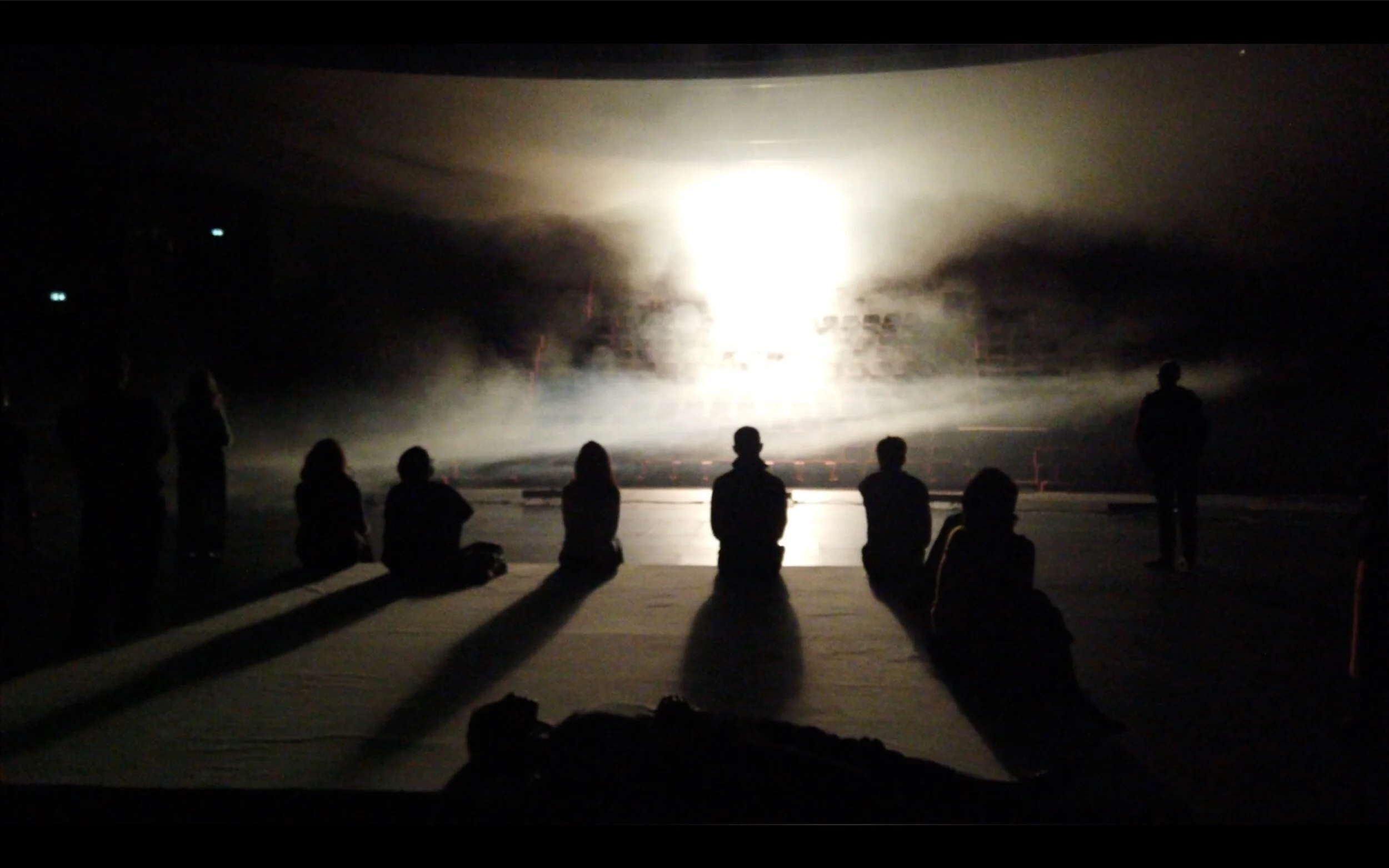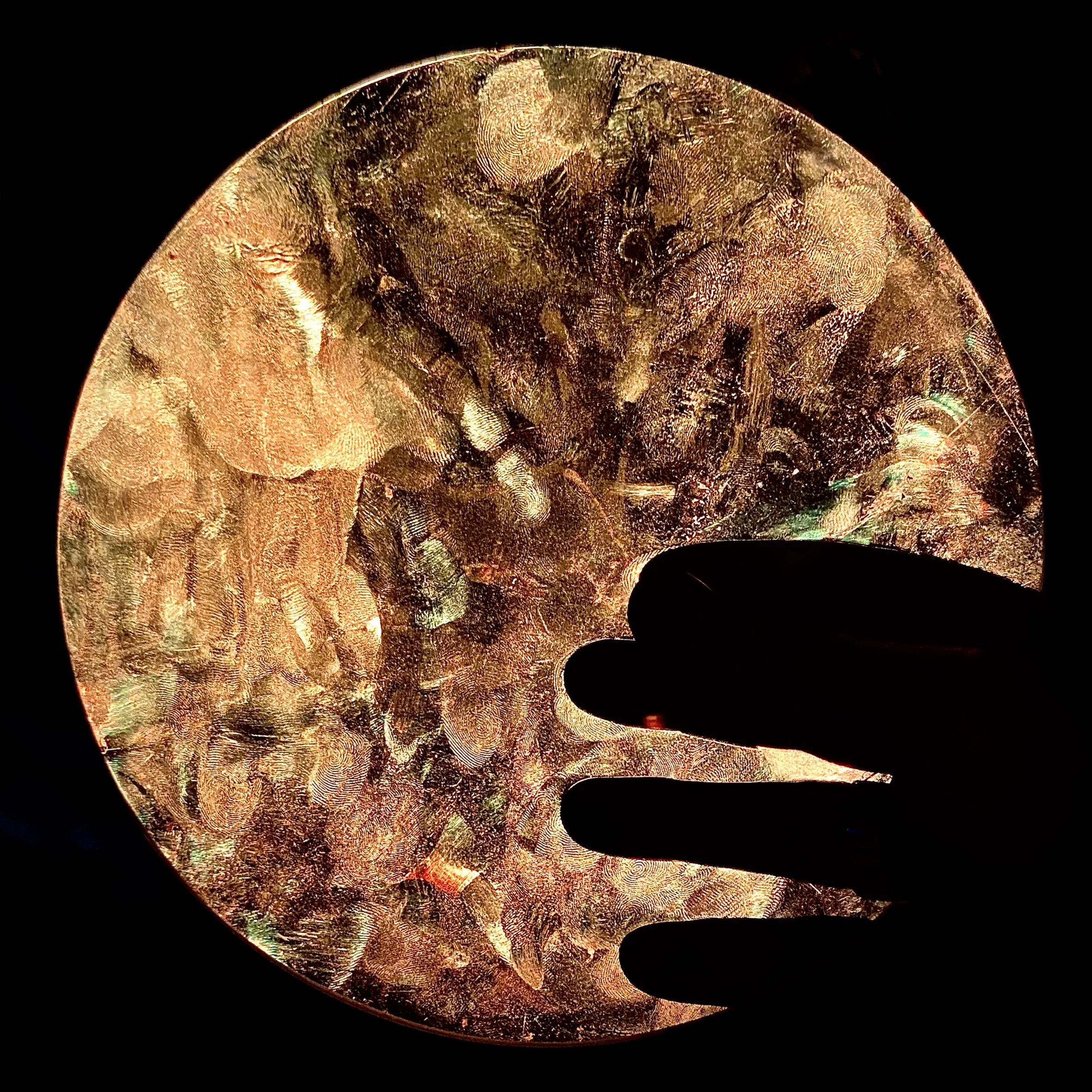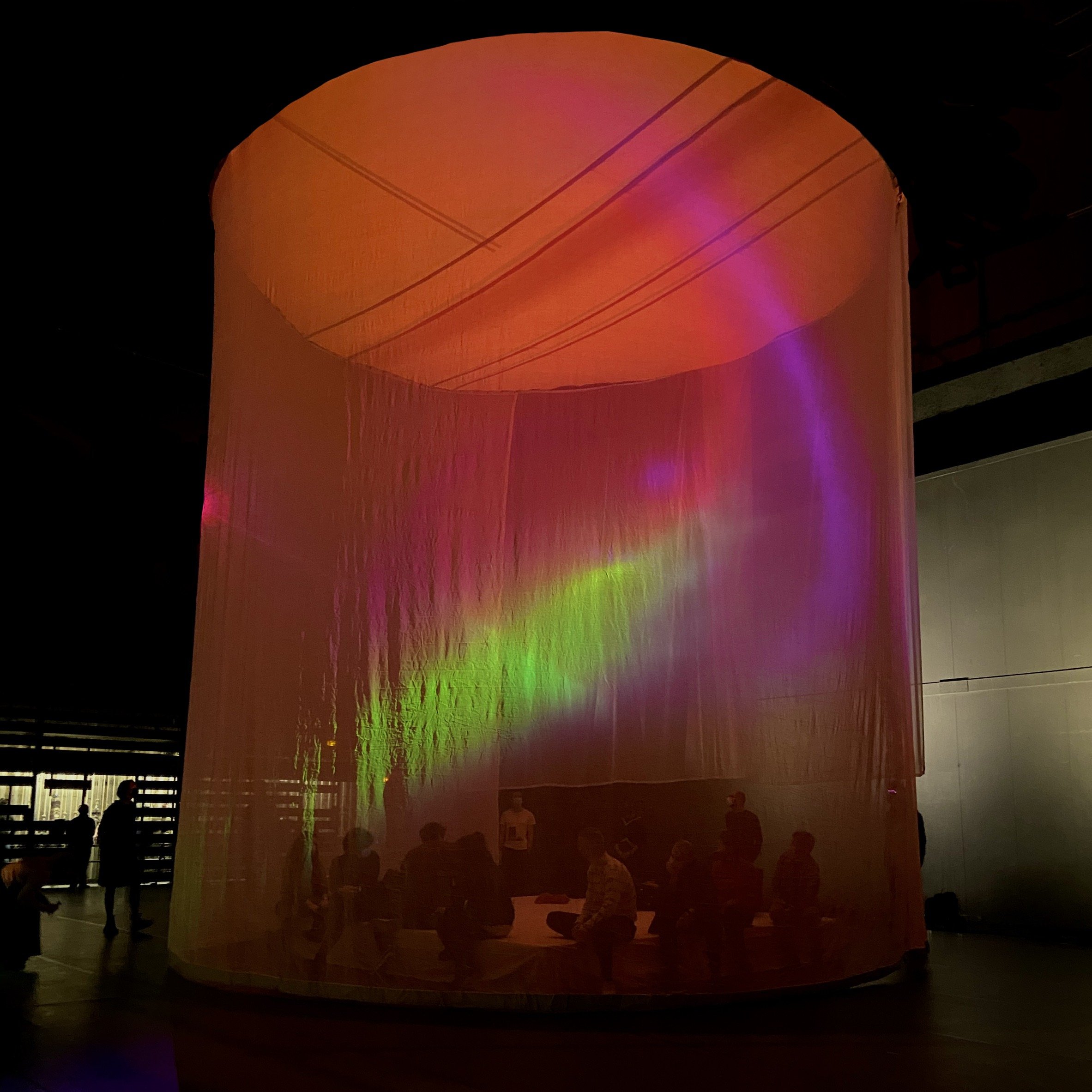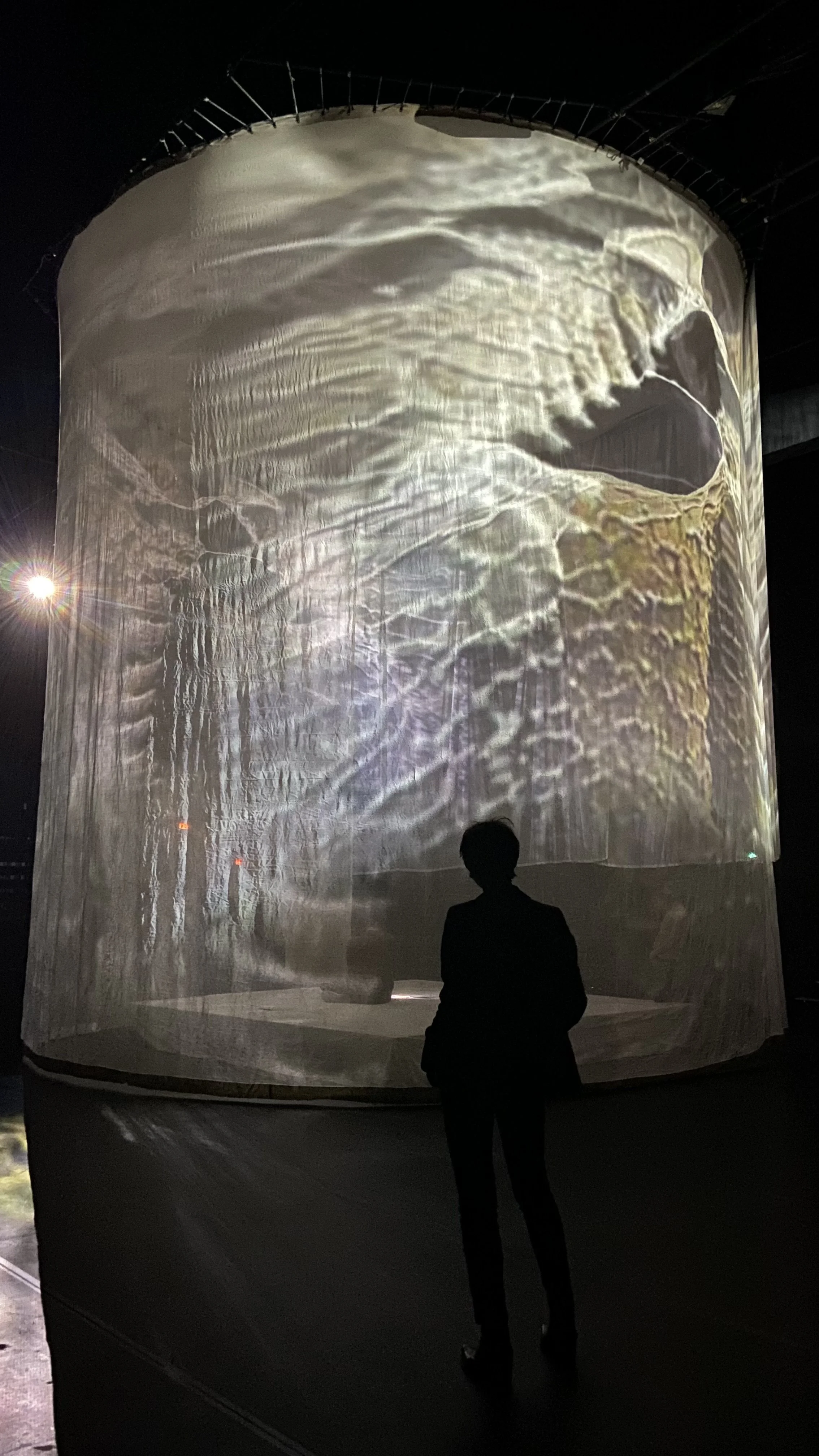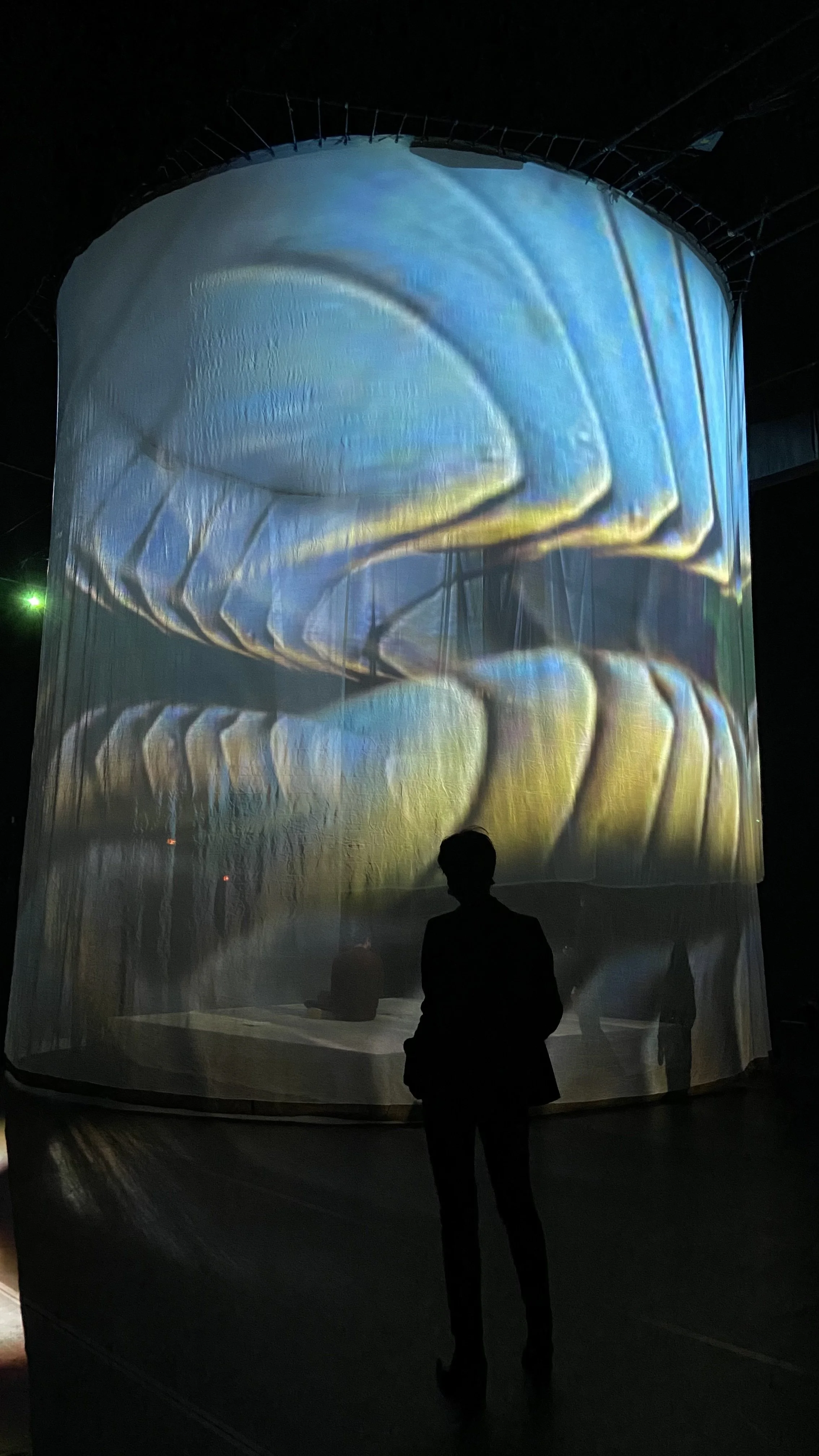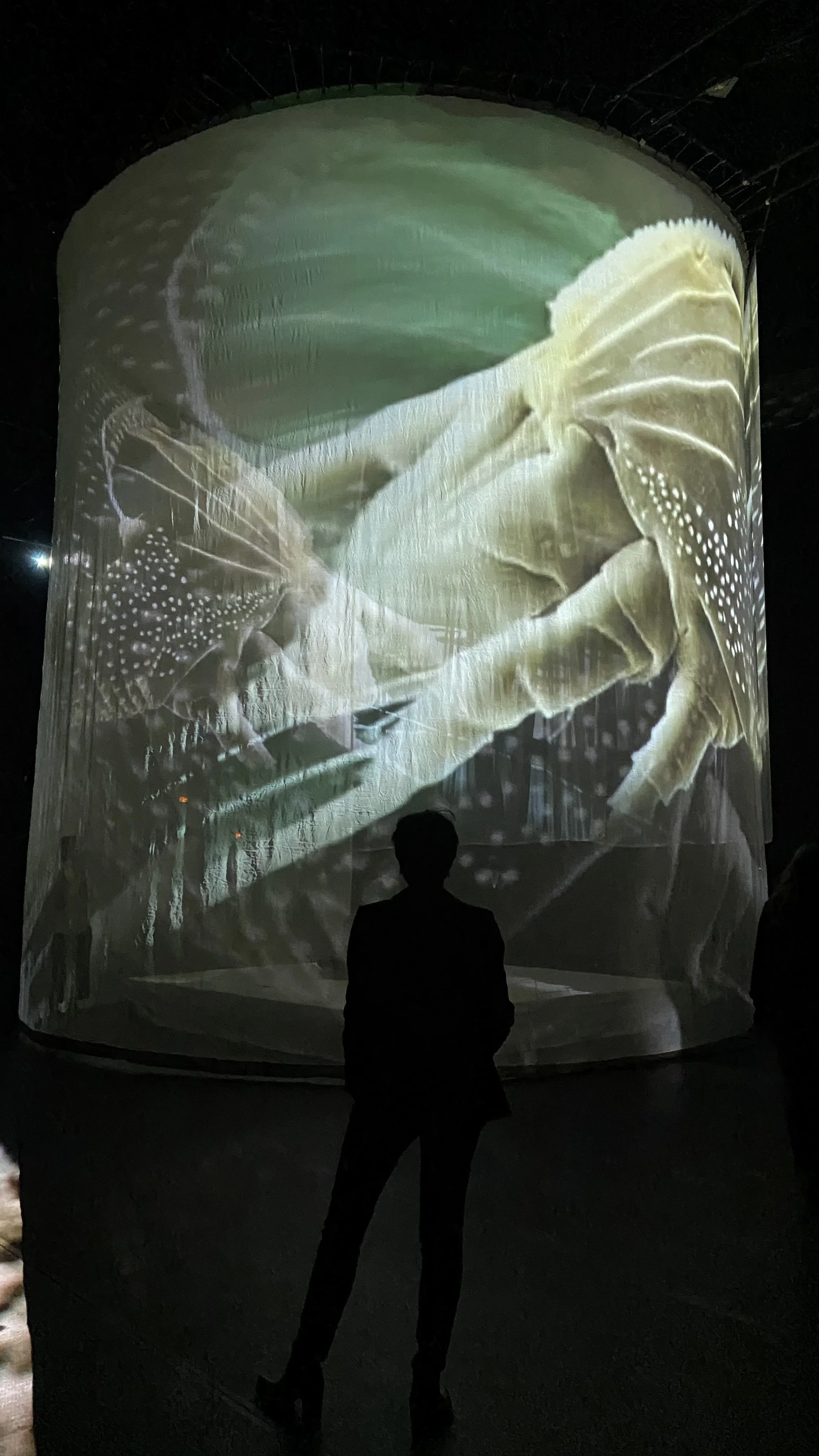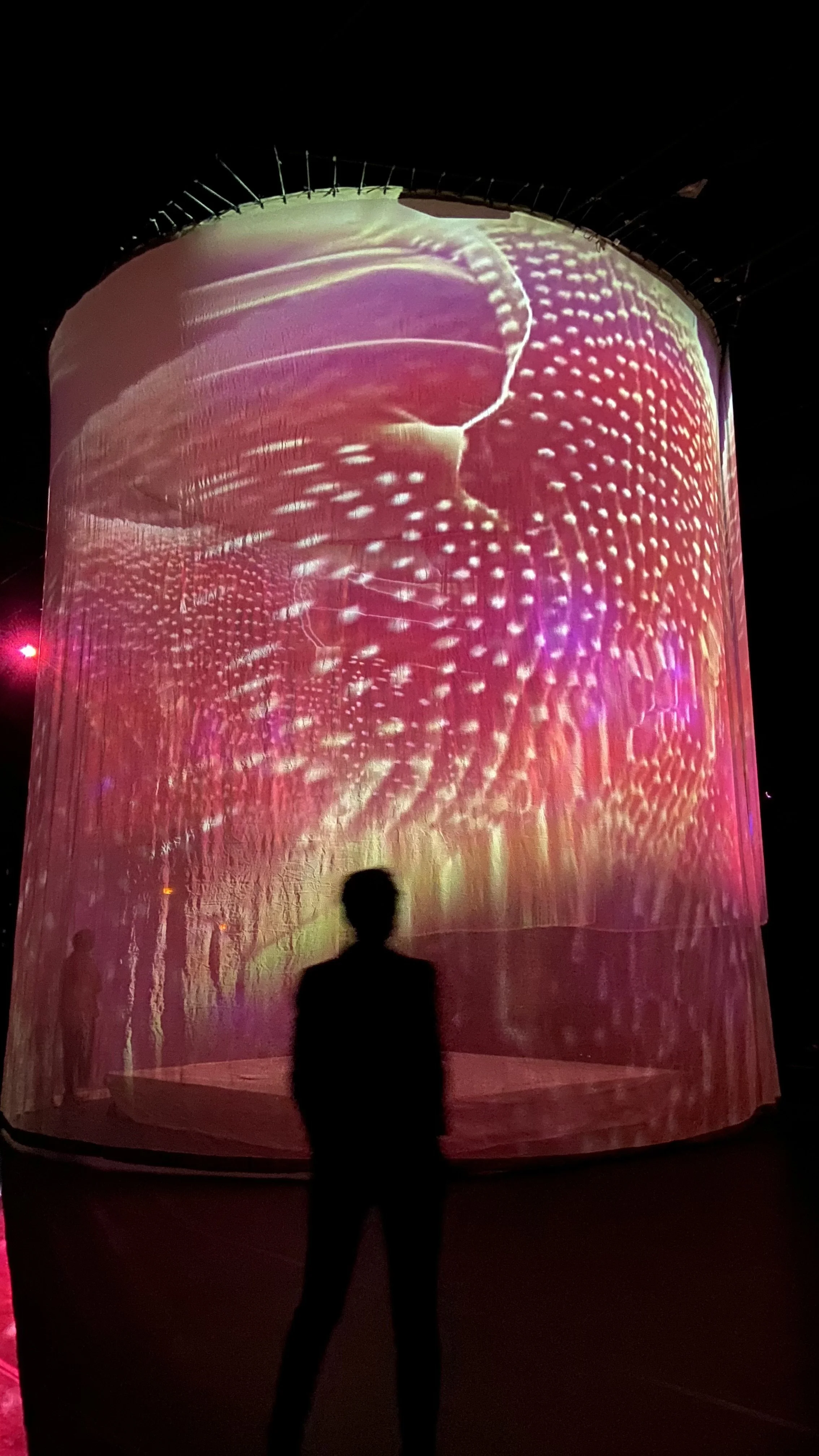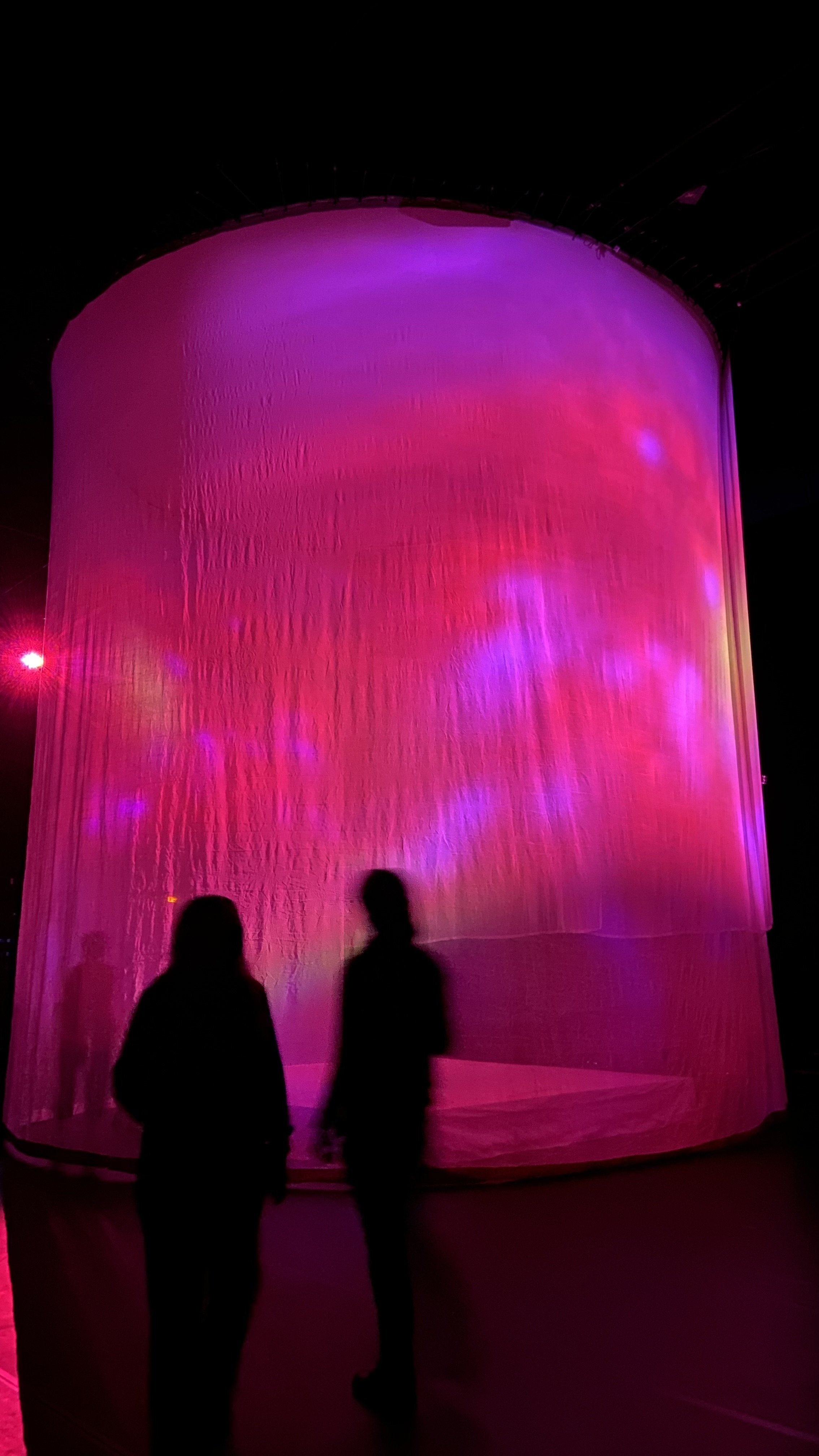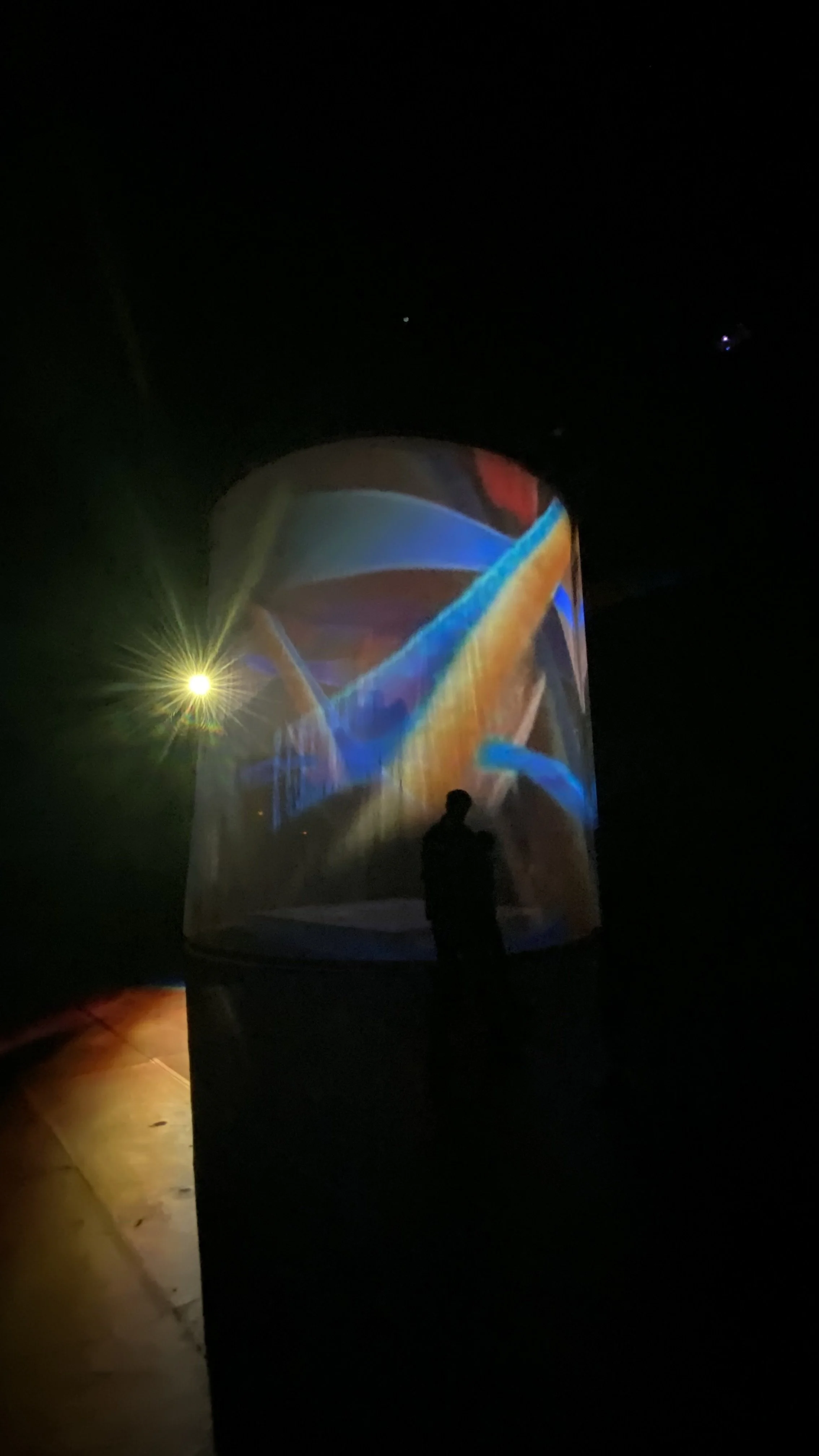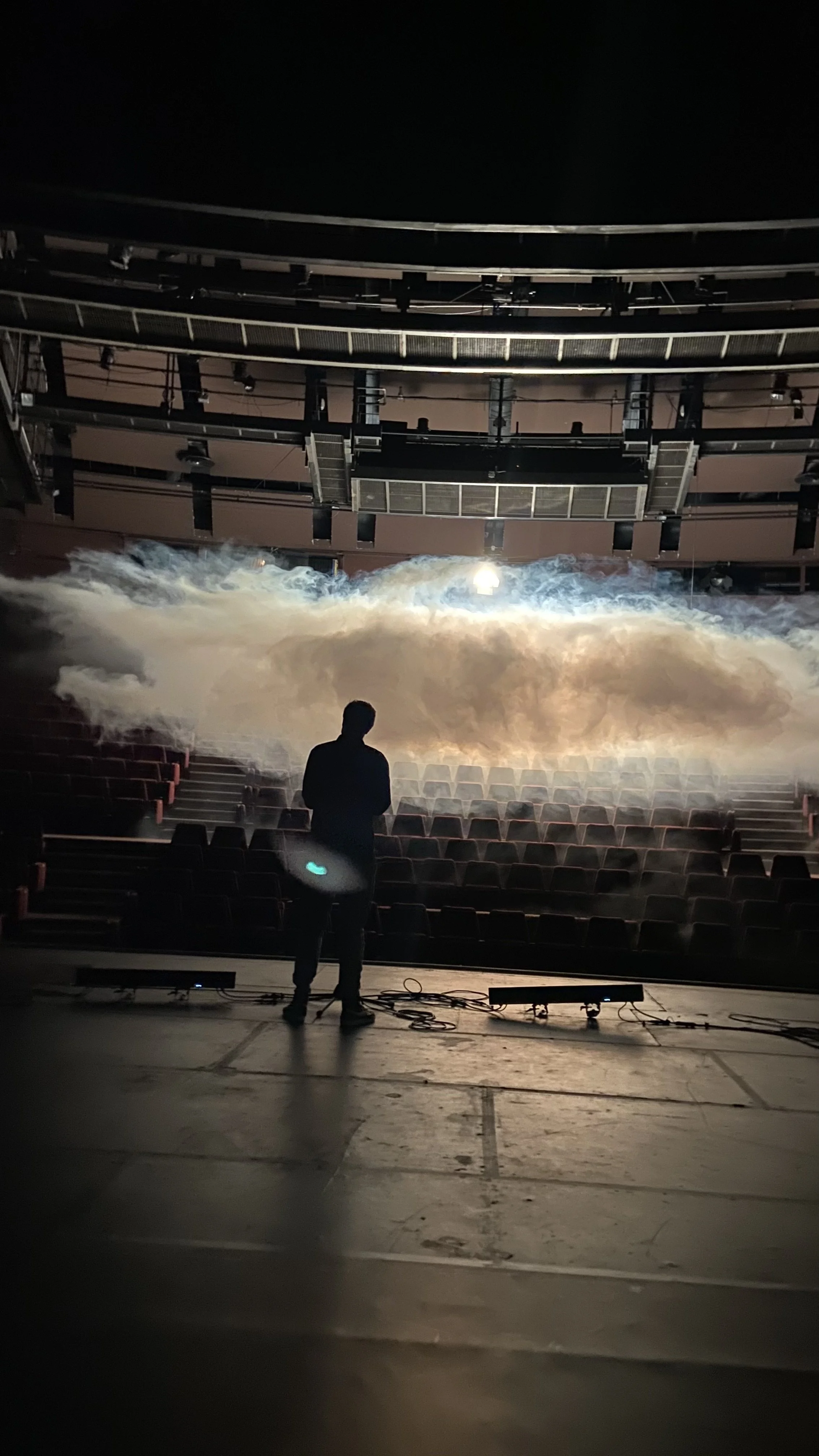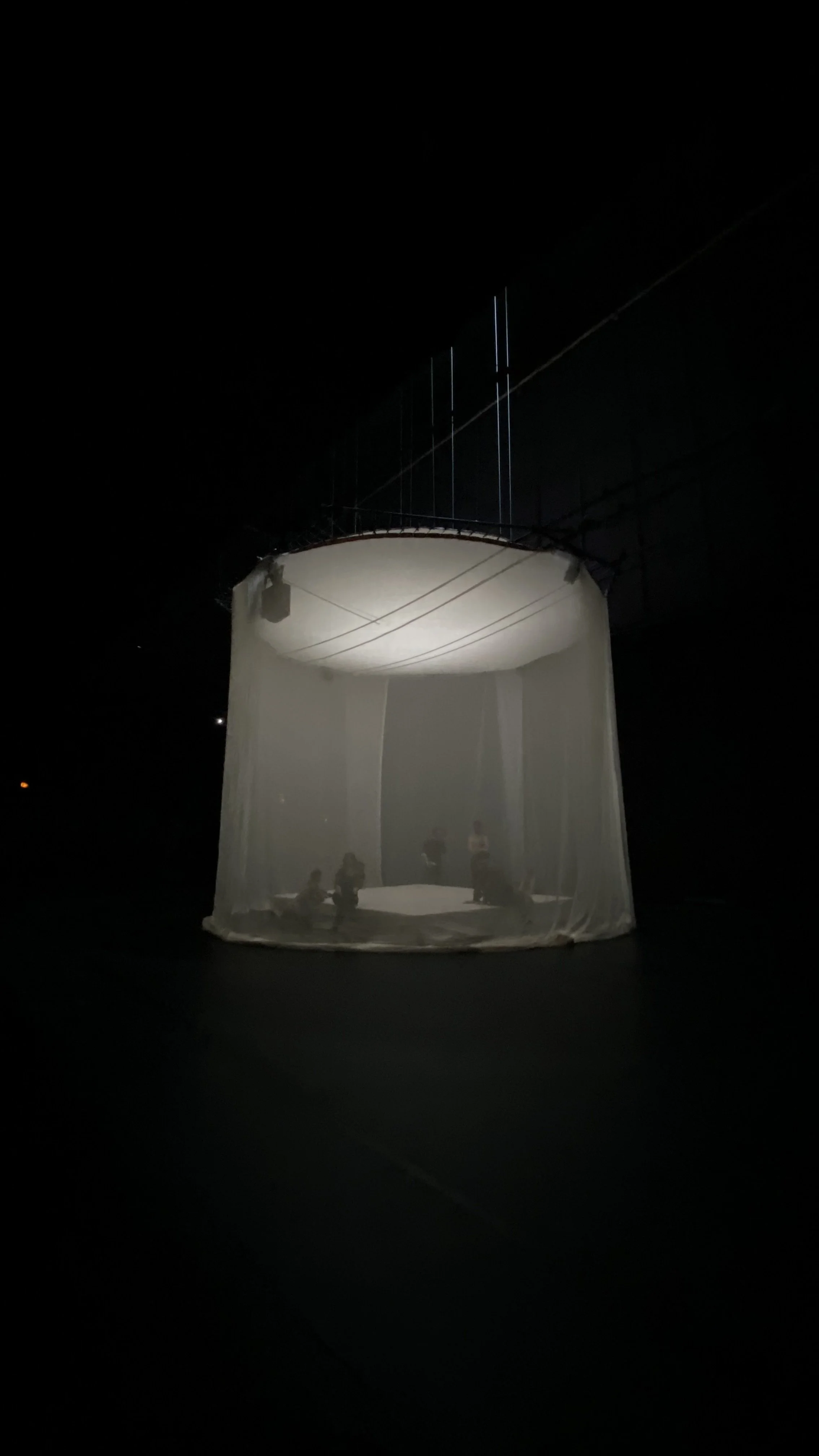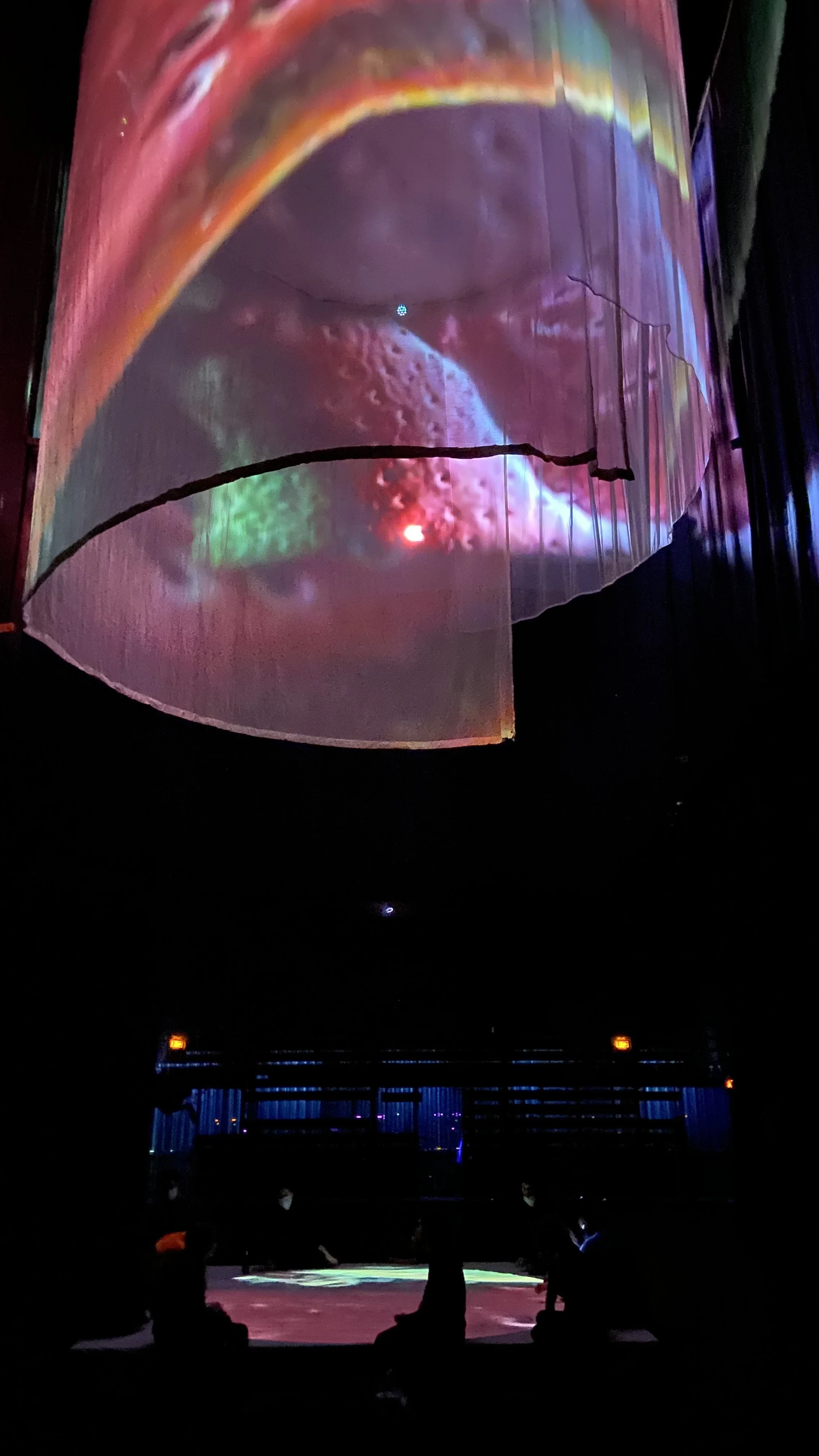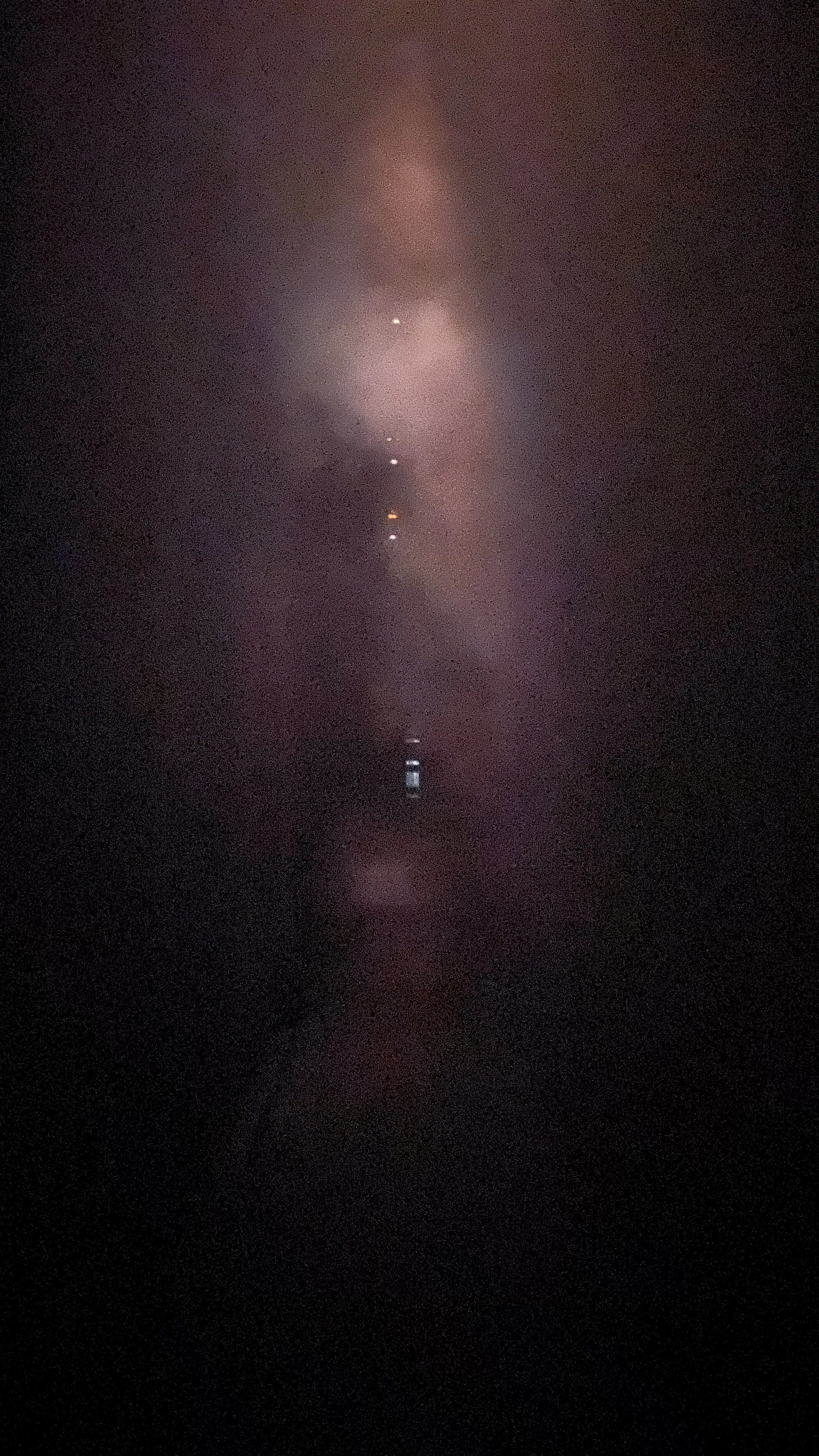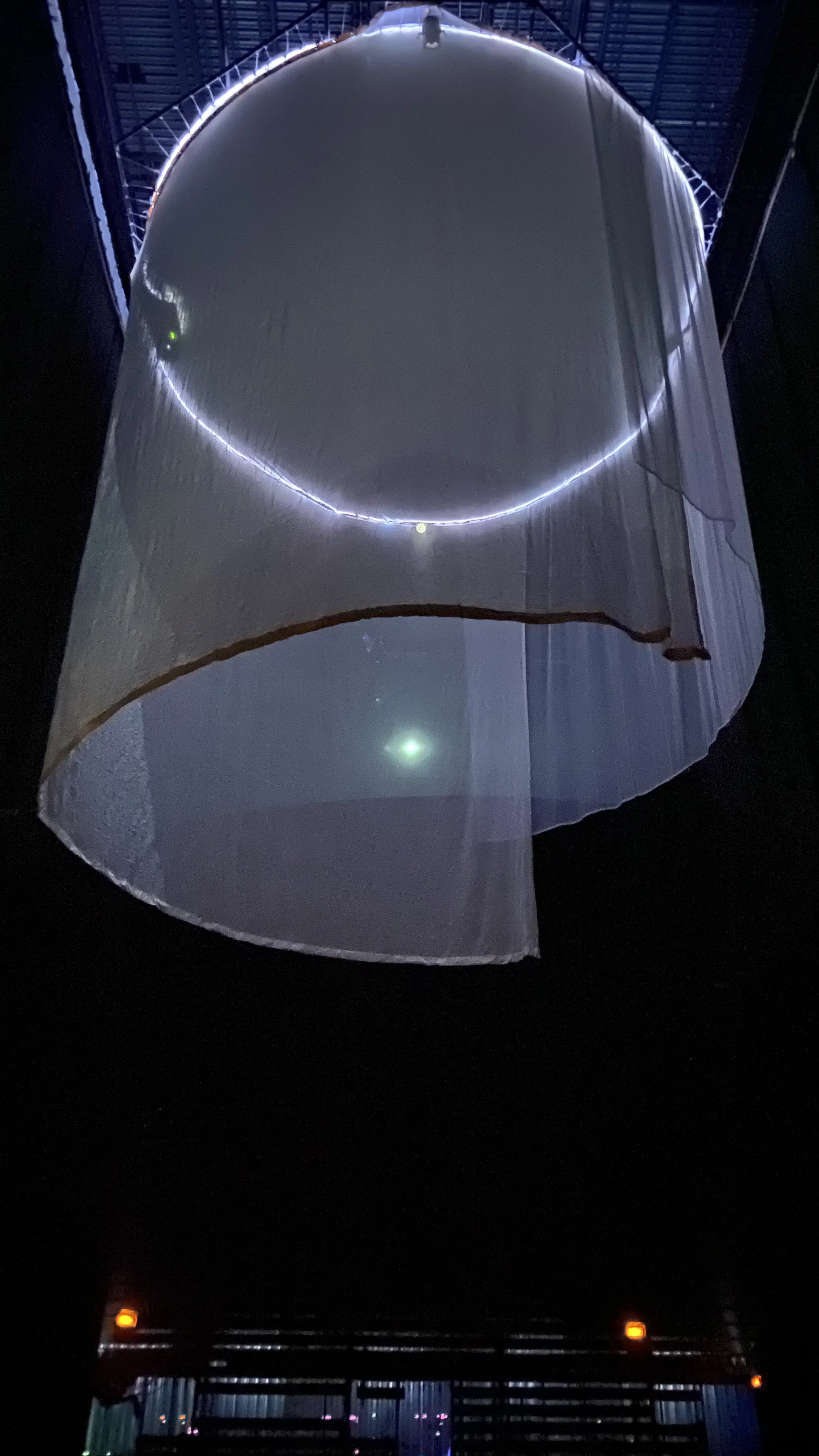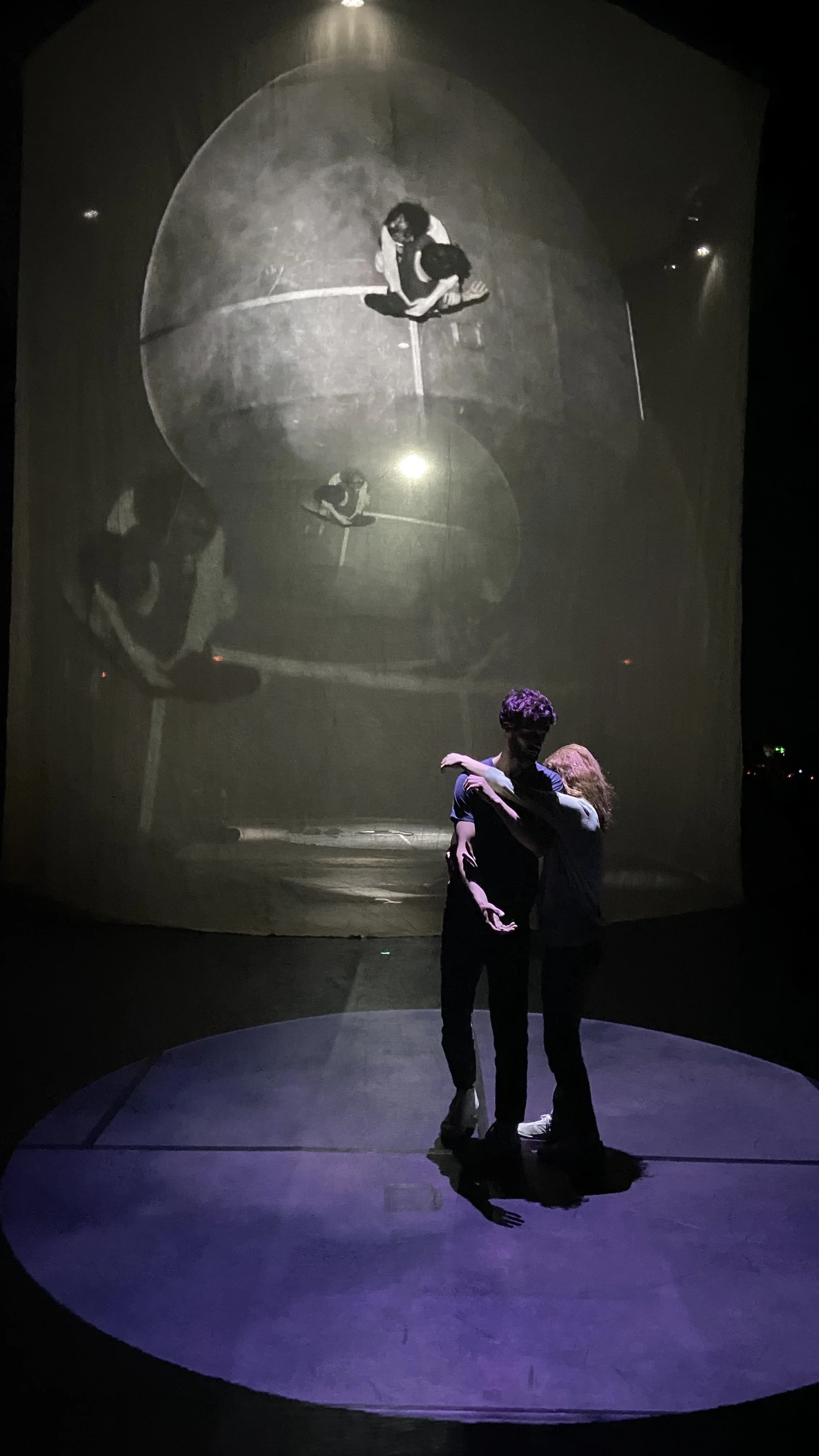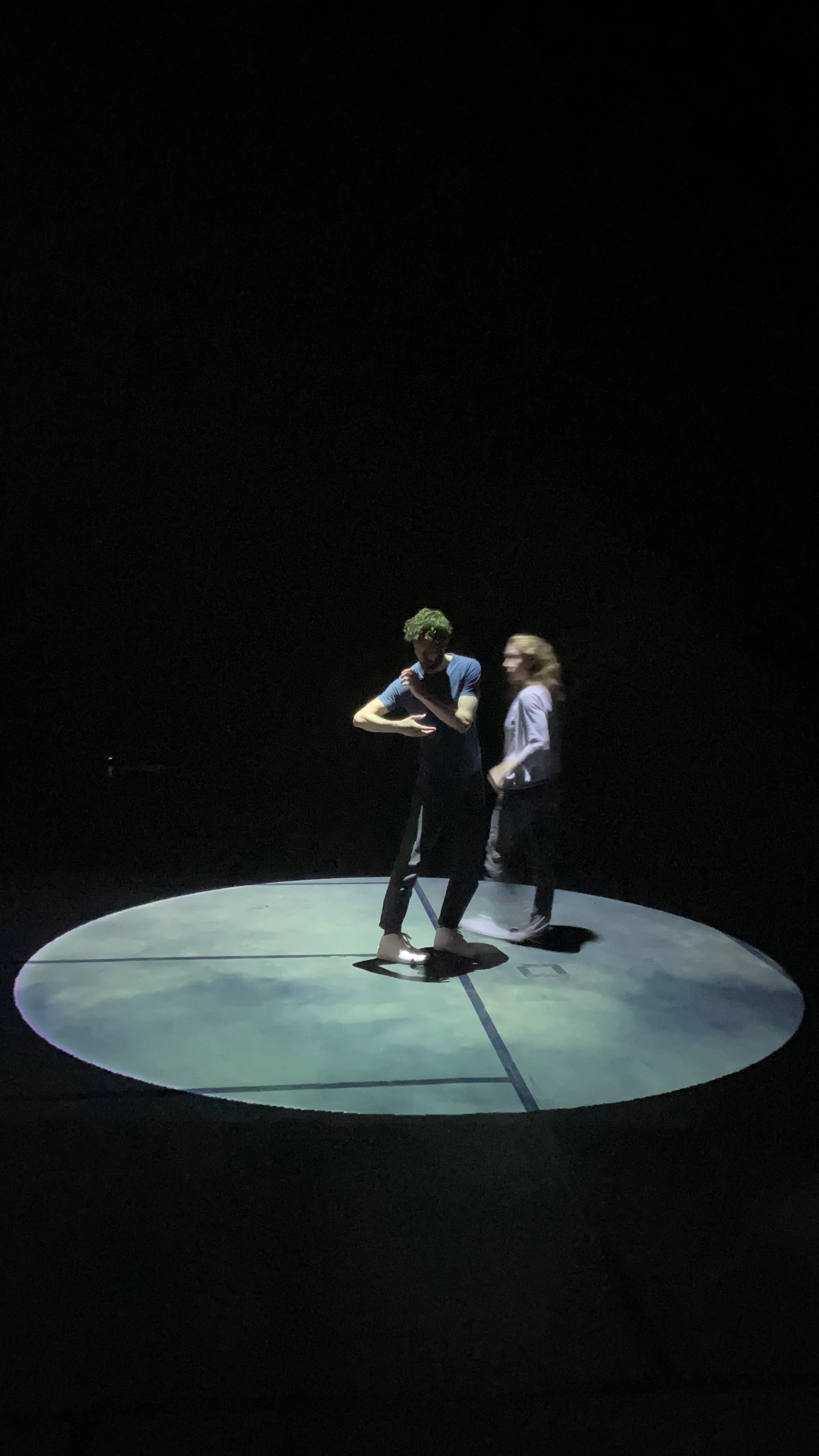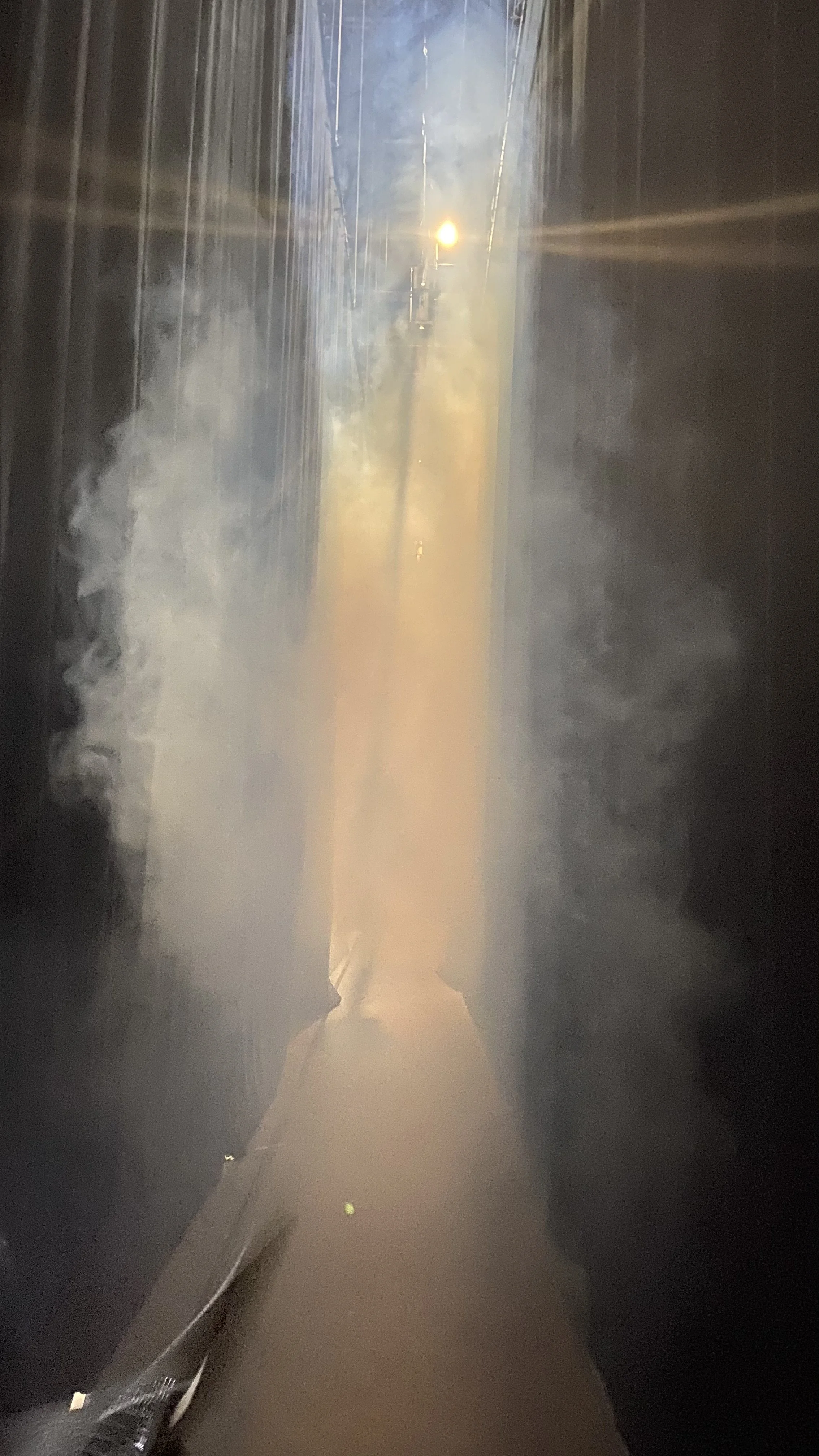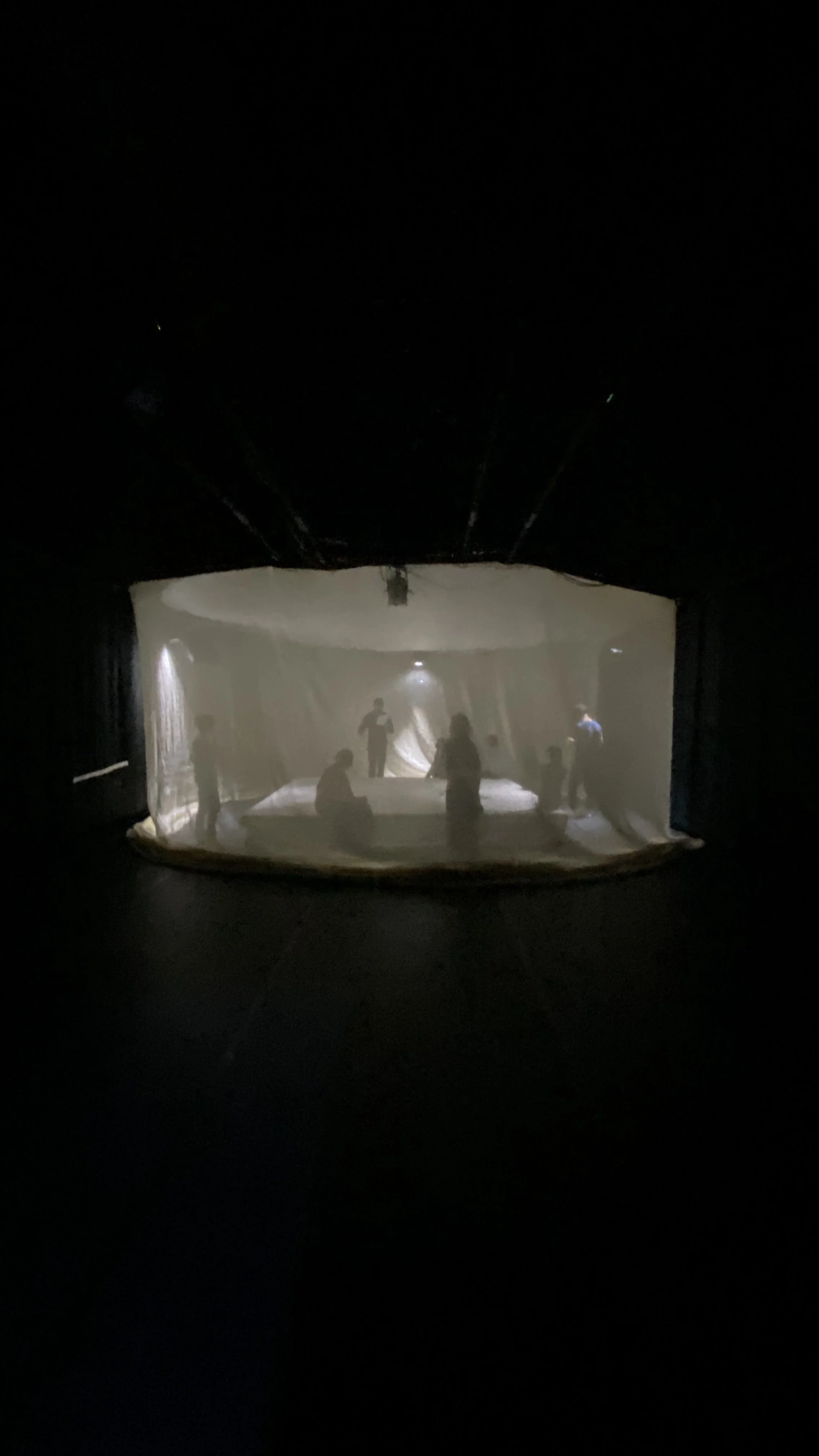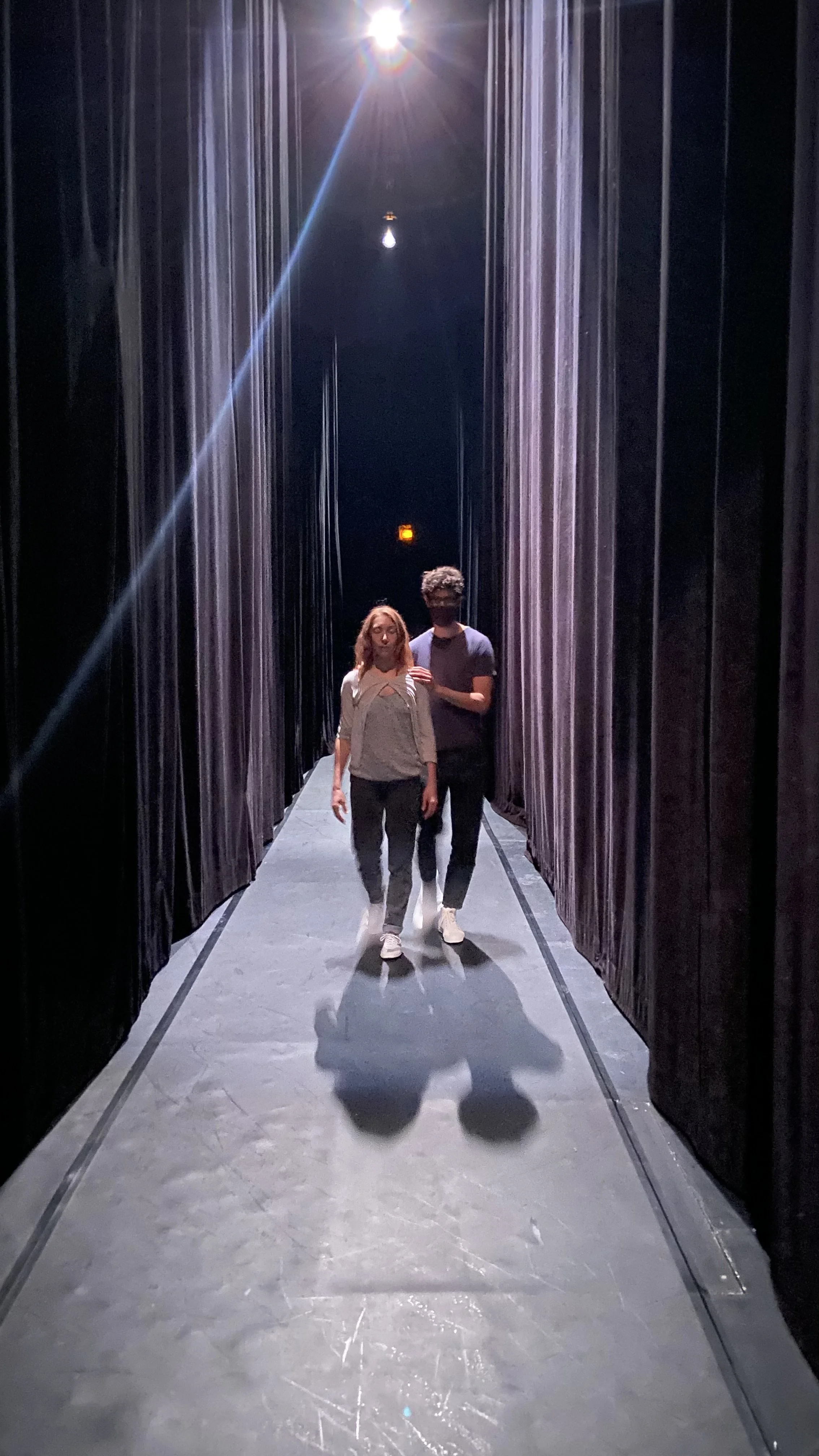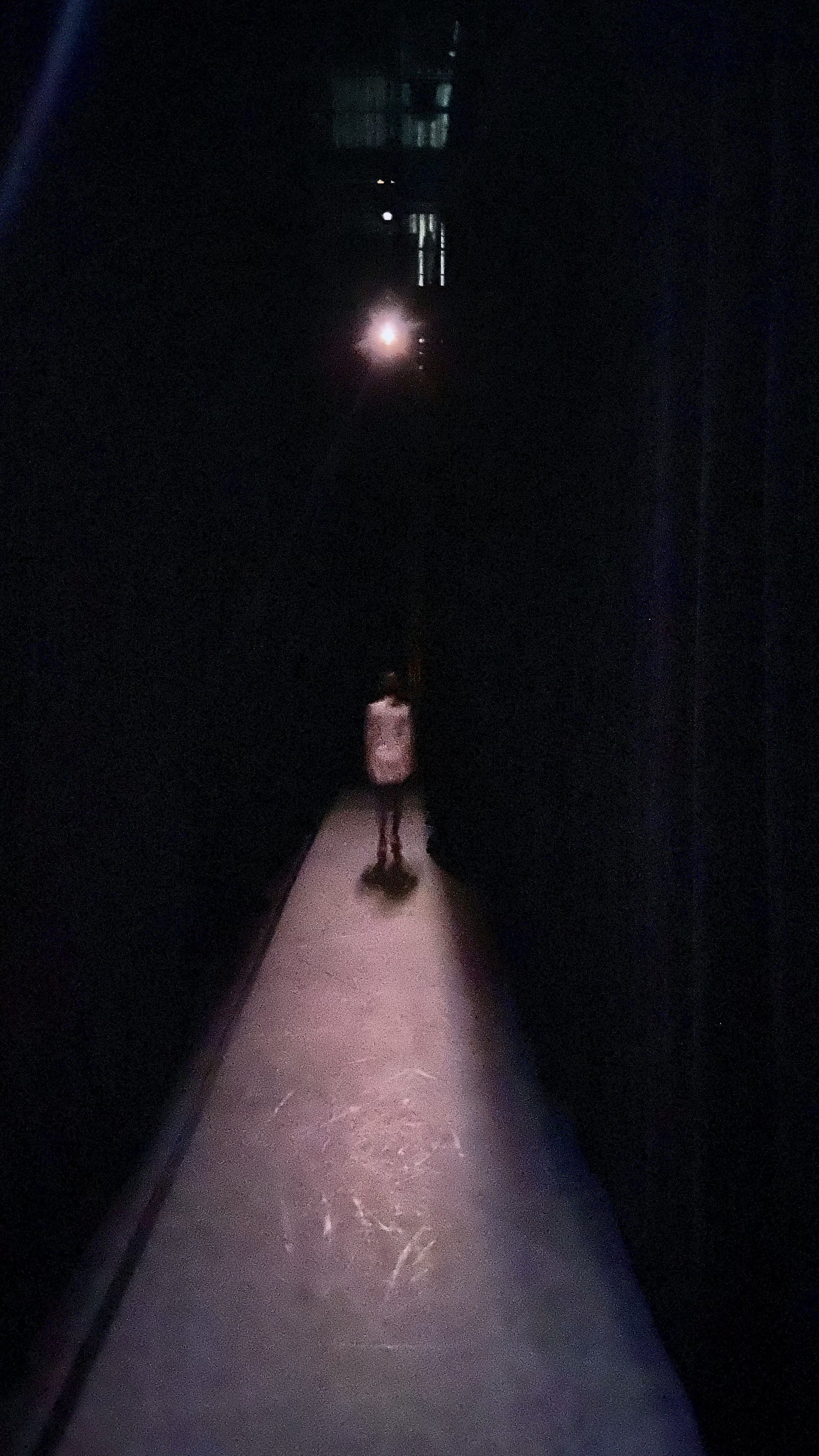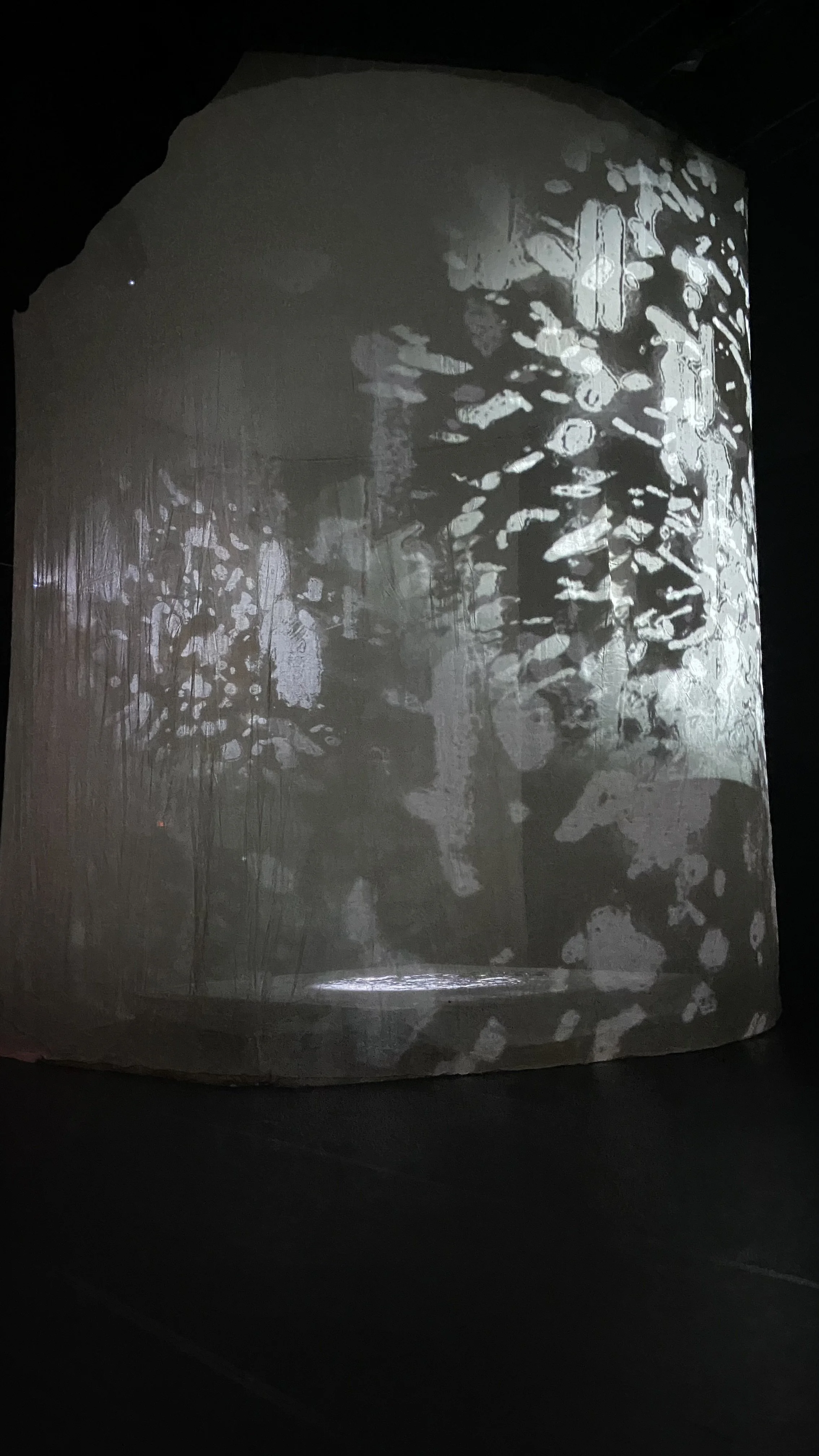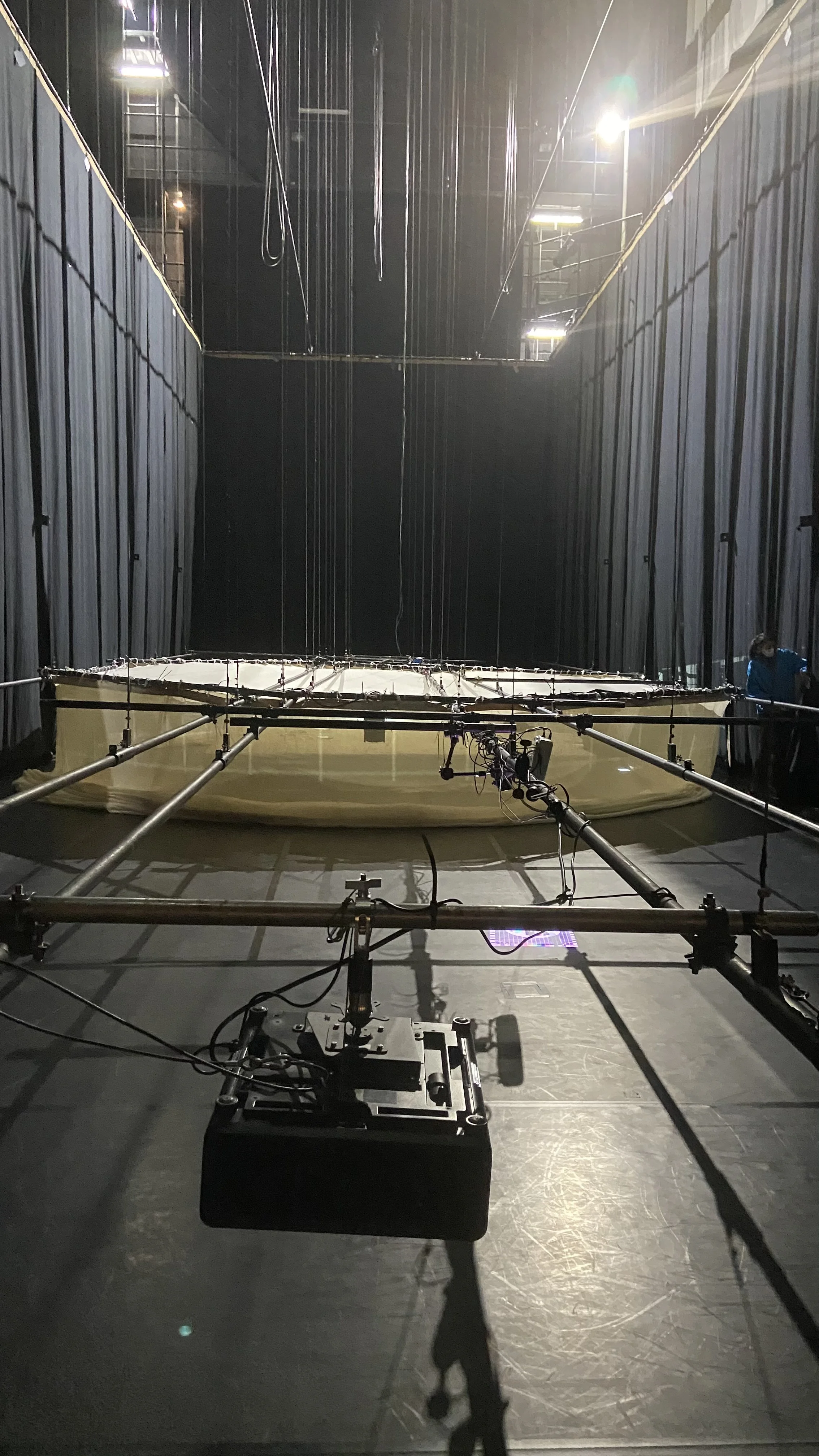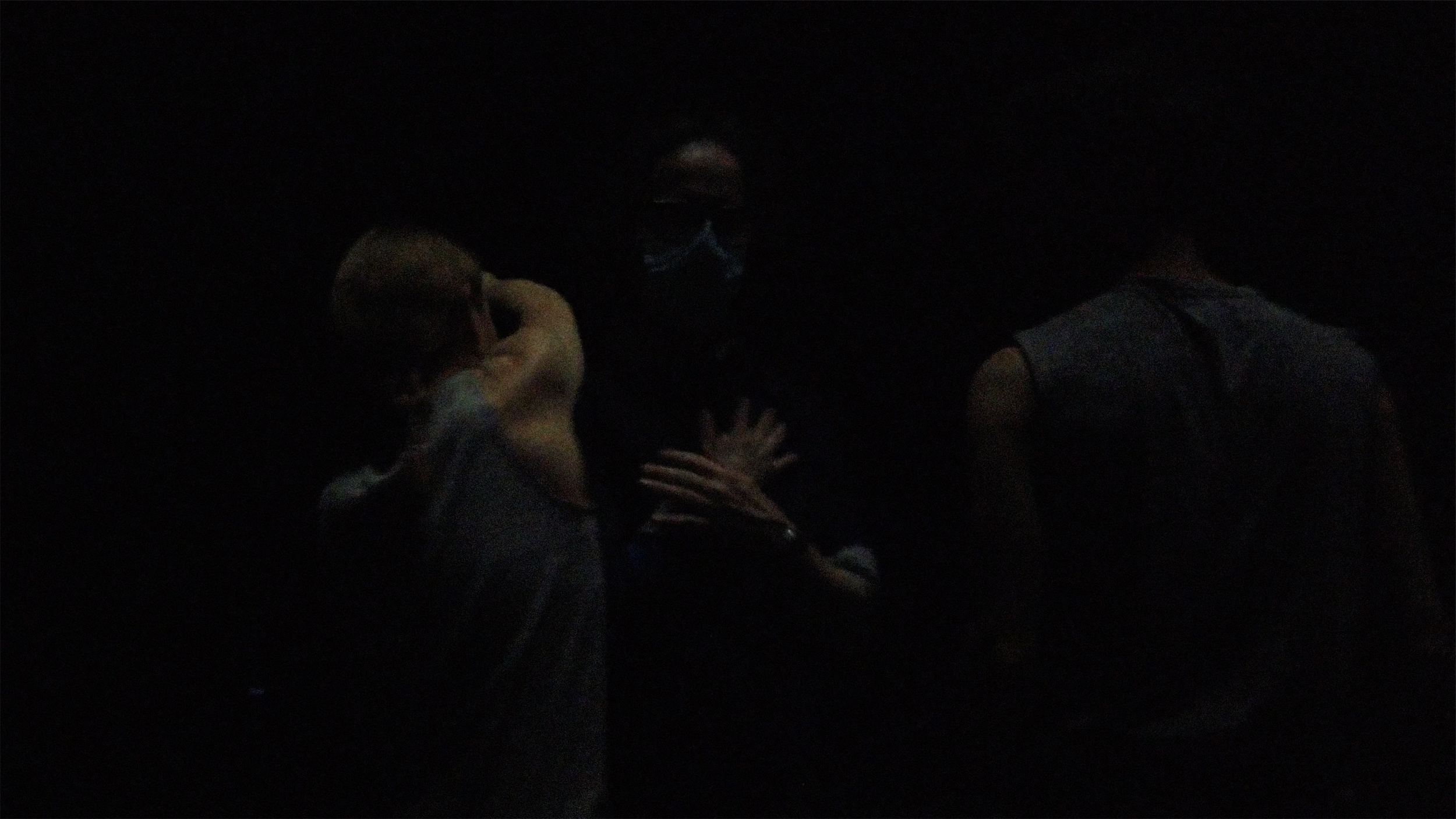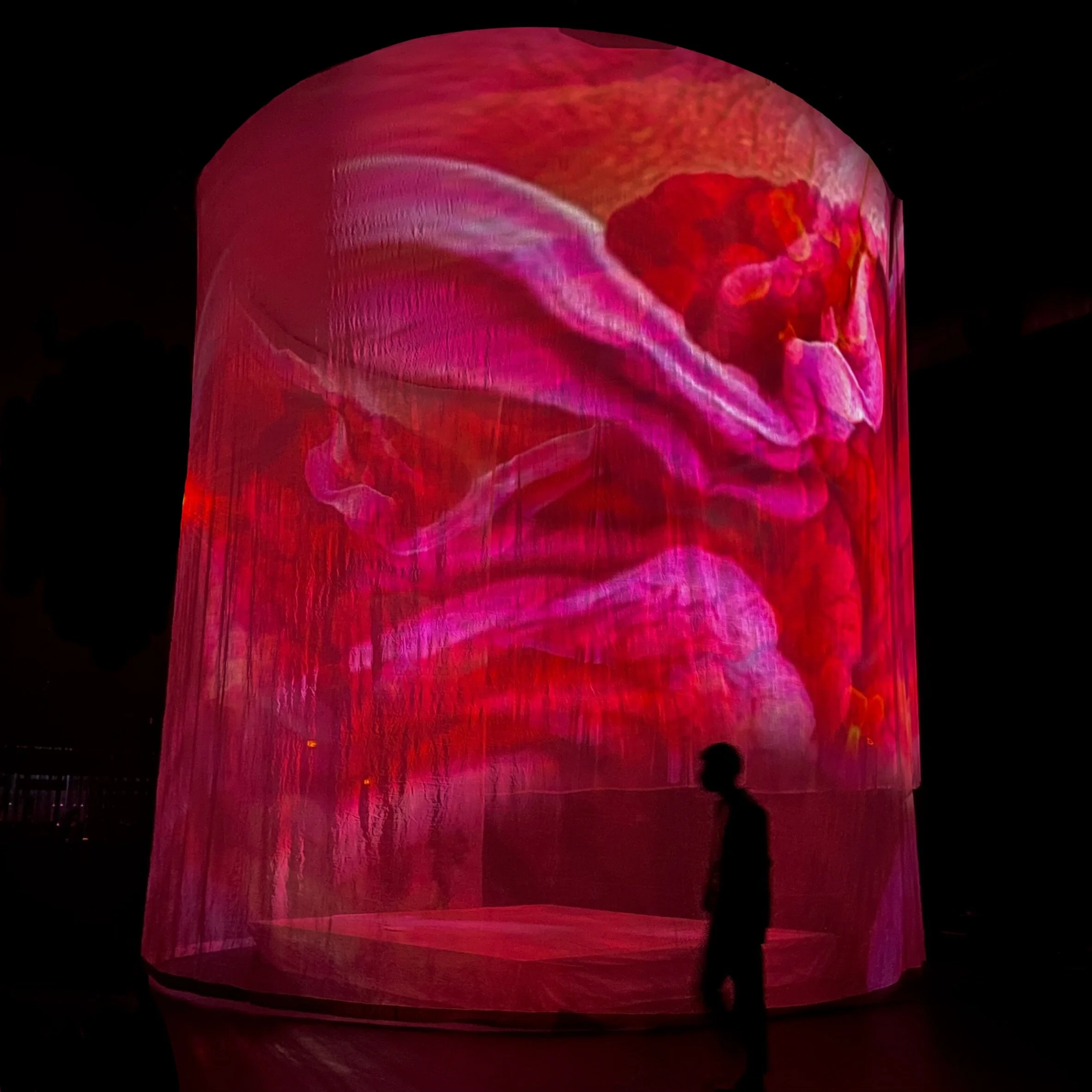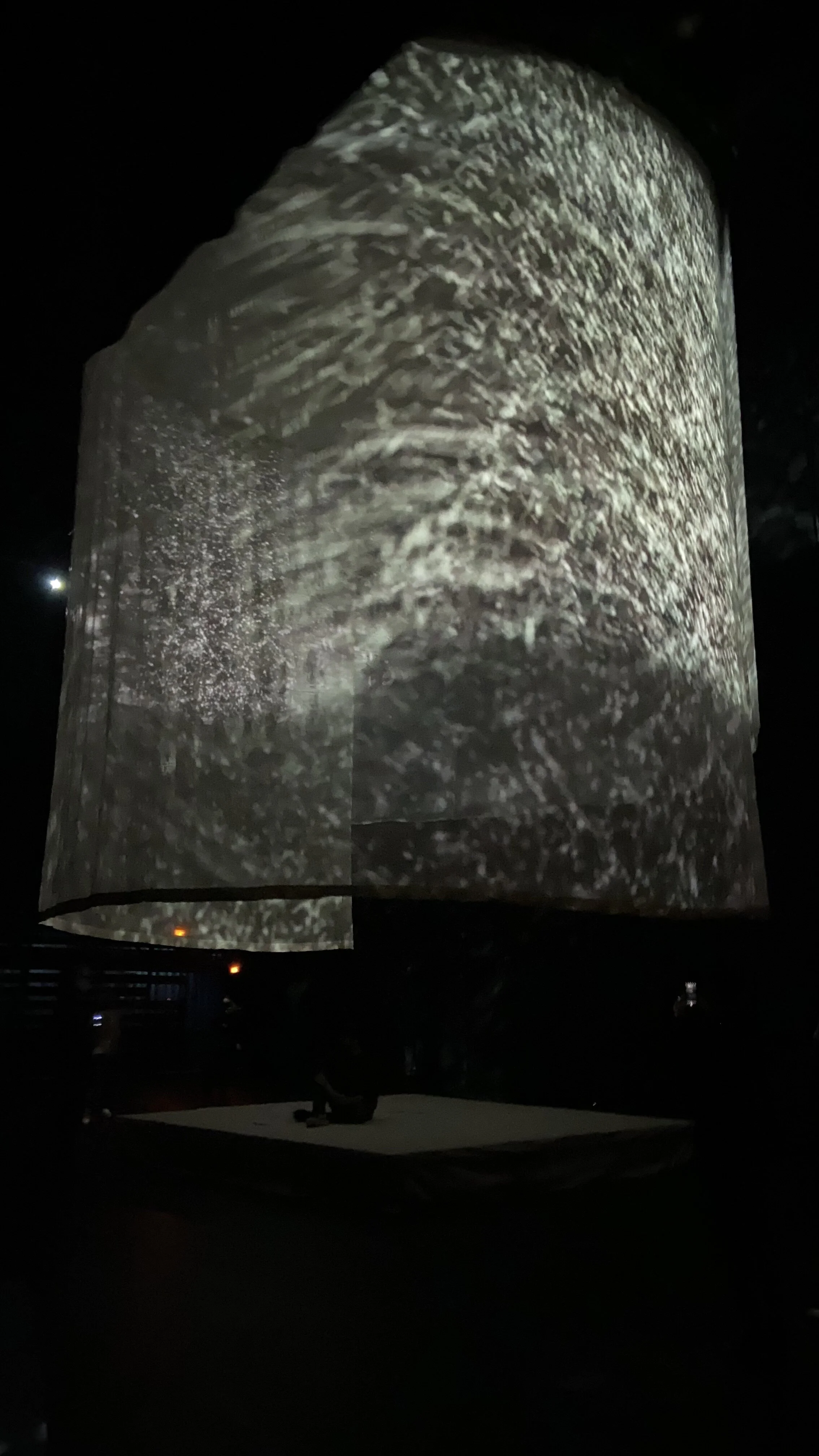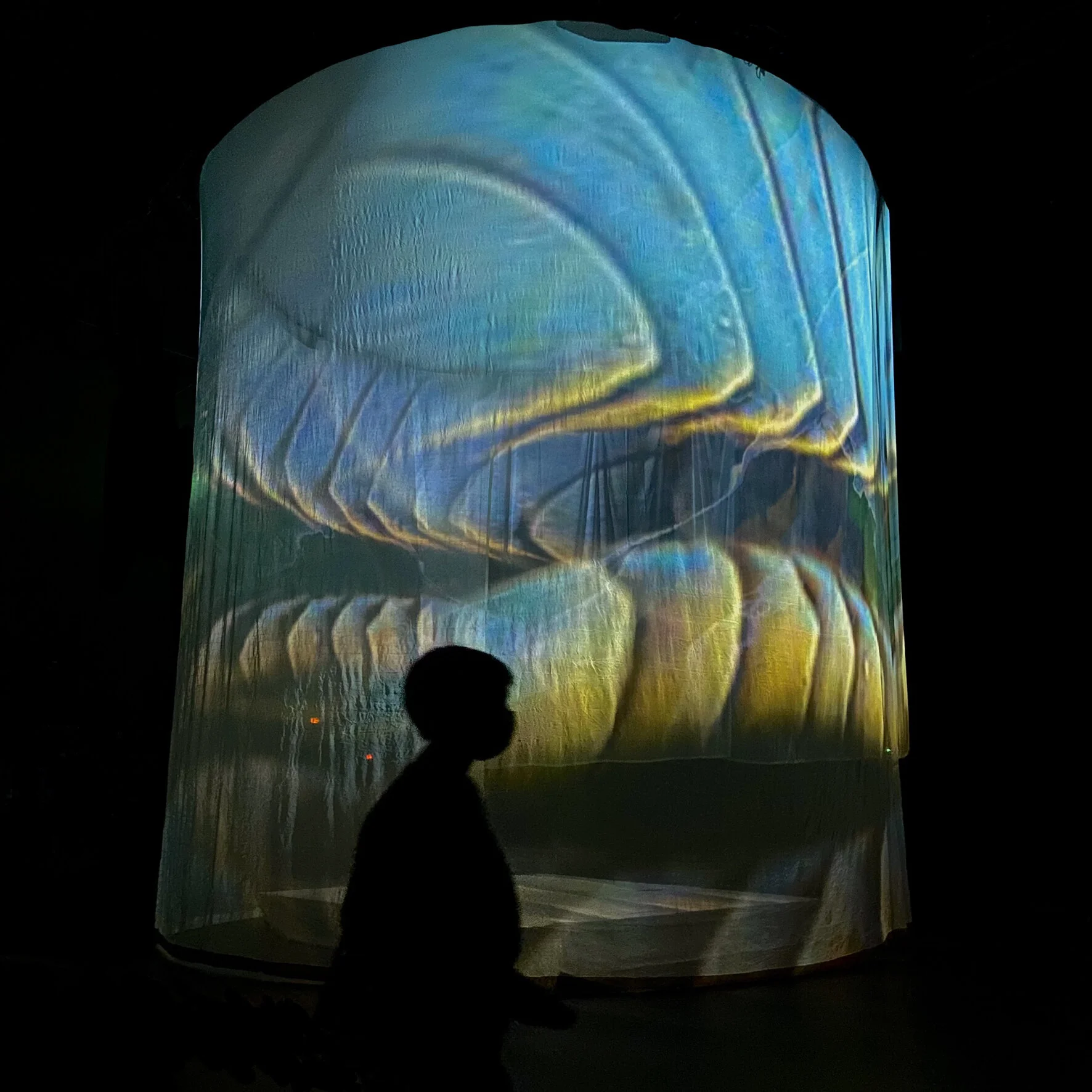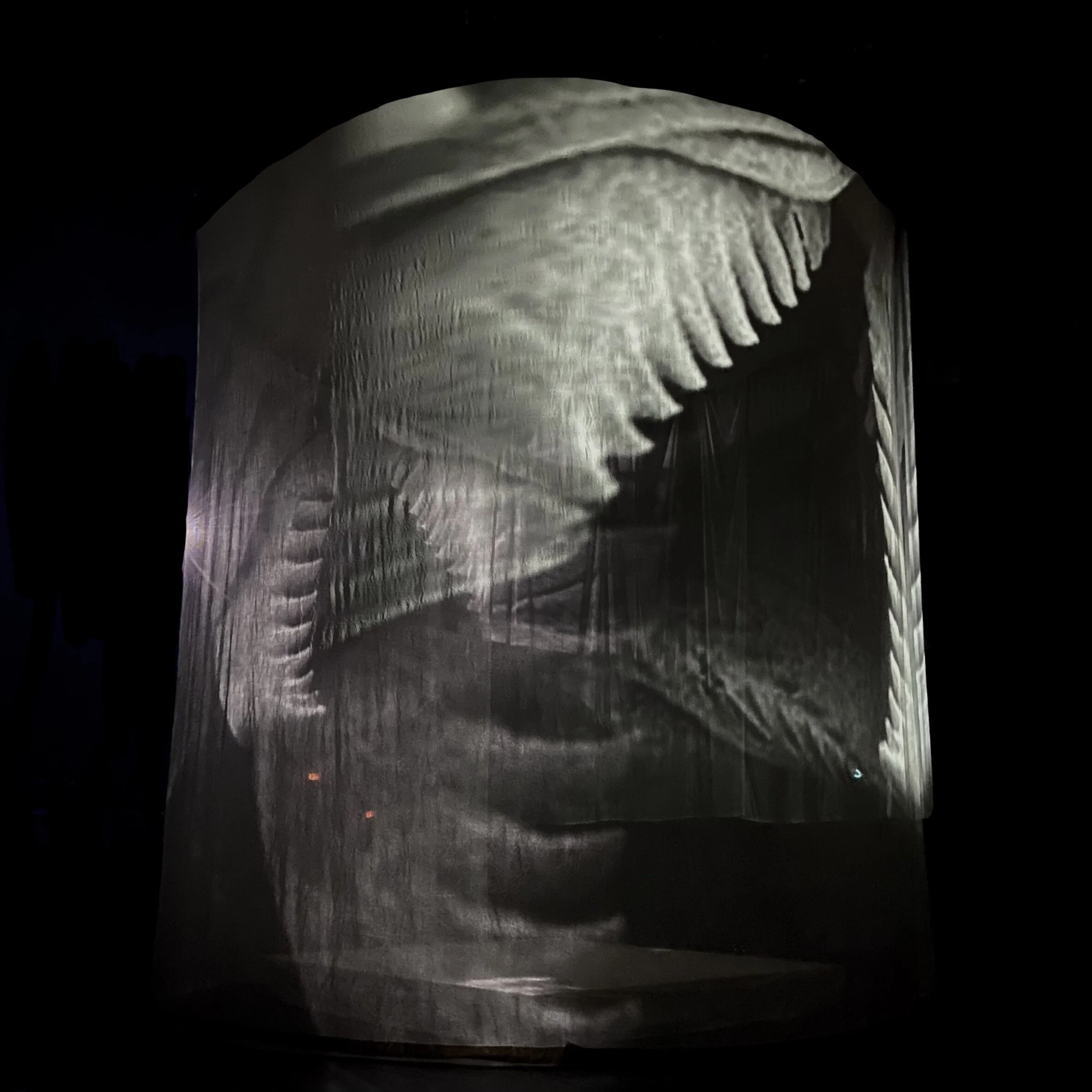VIral • V1 • 2022
•
VIral • V1 • 2022 •
Viral • Nanterre Amandiers
VIRAL, écrit par Bruno Latour et mis en scène par Frédérique Aït-Touati, explore les interrelations entre vivants et leur rapport à une planète en mutation. Mon travail de scénographie s’est attaché à matérialiser ces idées en proposant un dispositif scénique évolutif et immersif, conçu pour accompagner la déconstruction progressive de l’espace et des représentations.
Le point central de la scénographie est une table carrée, recouverte d’un textile réemployé issu des versions unplugged de INSIDE et Moving Earths. Cette table agit comme un espace hybride : à la fois plateforme scénique et table de travail, elle accueille des cartographies de Mars, des objets scientifiques et des masques réalisés par Marie-Sarah Adenis. Ces éléments soulignent l’ambivalence entre la fascination pour Mars, cette planète morte, et le questionnement de nos projections sur cet ailleurs.
La mise en scène débute par une exposition de photographies suspendues, des images retouchées pour évoquer des paysages martiens. Ces clichés, éclairés et intégrés à la scénographie, interrogent la manière dont nous construisons nos représentations scientifiques et esthétiques. Ils introduisent un espace d’observation et de réflexion pour le public, avant que la performance n’entame un basculement.
Un écran de tulle cloisonne d’abord le plateau, créant un espace où les spectateurs présents se déplacent. À mesure que la performance progresse, le tulle tombe, révélant la structure scénique et décomposant les frontières entre espace scénique et espace spectateur. La fumée, montant de sous la table, s’étend progressivement, altérant la perception de l’espace et transformant l’environnement en une scène mouvante, presque insaisissable.
Les projections, quant à elles, sont conçues pour dépasser une fonction illustrative. Elles s’étendent au-delà de la table, jouant sur les échelles pour lier des dimensions biologiques et cosmiques, et pour interroger la tension entre observation scientifique et interprétation symbolique.
Enfin, la création sonore accompagne cette dynamique. En mêlant des captations et des compositions, elle installe une ambiance enveloppante qui soutient les transformations de l’espace et participe à l’expérience immersive du projet.
Cette version de VIRAL a représenté une étape essentielle dans la construction de la Trilogie Terrestre, en explorant de nouvelles façons de repenser les espaces de représentation. Mon approche a consisté à réinterpréter les matériaux disponibles, à concevoir des espaces modulables et à m’adapter aux évolutions du projet, tout en maintenant une réflexion constante sur la manière dont le dispositif scénique peut soutenir le propos de la performance et enrichir la relation entre spectateurs, espace et texte.
VIRAL, written by Bruno Latour and directed by Frédérique Aït-Touati, explores the interrelations between living beings and their relationship to a planet in flux. My scenographic work sought to materialize these ideas by creating an evolving, immersive stage design intended to accompany the progressive deconstruction of space and representation.
At the heart of the scenography lies a square table, covered with reused fabric repurposed from the unplugged versions of INSIDE and Moving Earths. This table serves as a hybrid space—both a stage platform and a workspace—featuring maps of Mars, scientific objects, and masks created by Marie-Sarah Adenis. These elements highlight the duality between our fascination with Mars, a dead planet, and the critique of our projections onto such an otherworldly destination.
The performance begins with an exhibition of suspended photographs, retouched to evoke Martian landscapes. These illuminated and scenographically integrated images question how we construct our scientific and aesthetic representations. They establish a space of observation and contemplation for the audience before the performance shifts into another phase.
A tulle screen initially encloses the stage, creating a space where the audience members can move around. As the performance unfolds, the tulle falls, revealing the scenographic structure and breaking down the boundaries between the stage and the spectators. Smoke rising from beneath the table gradually spreads, altering the perception of the space and transforming the environment into a fluid, almost elusive scene.
The projections were designed to go beyond a mere illustrative function. They expand beyond the table, playing with scale to connect biological and cosmic dimensions, while interrogating the tension between scientific observation and symbolic interpretation.
Finally, the sound design accompanies this dynamic evolution. By blending field recordings with compositions, it creates an enveloping atmosphere that supports the transformation of the space and enhances the project’s immersive experience.
This version of VIRAL marked a critical step in the development of the Trilogie Terrestre, exploring new ways to rethink performance spaces. My approach focused on reinterpreting available materials, designing modular spaces, and adapting to the project’s evolution, all while consistently reflecting on how the scenographic setup could support the performance’s narrative and enrich the interplay between the audience, the space, and the text.
Diffusion :
• 14 octobre 2019 : Hans Rausing Lecture (Uppsala, Suède)
• 7 décembre 2019 : Théâtre Nanterre-Amandiers (Nanterre, France)
• 20 janvier 2020 : Théâtre de l’Odéon (Paris, France)
• 6 février 2020 : Collège des Bernardins (Paris, France)
• 13 août - 13 septembre 2020 : Berliner Festspiele - Gropius Bau, Down to Earth (Berlin, Allemagne) – Versions unplugged (5 représentations)
• 20 août 2020 : Théâtre Benno Besson (Yverdon-les-Bains, Suisse)
• 28 juin 2021 : Théâtre de la Criée, Festival de Marseille (Marseille, France)
• 28 août 2021 : Les Rencontres Inattendues (Tournai, Belgique)
• 5 octobre 2021 : Hexagone (Meylan, France)
• 13 octobre 2021 : BOCA Biennal of Contemporary Arts (Lisbonne, Portugal)
• 6 novembre 2021 - 4 avril 2022 : Projection - Centre Pompidou Metz invite la Biennale de Taipei
• 3 décembre 2021 : Villa Albertine, Institut Français et Goethe-Institut (Atlanta, États-Unis)
• 21 mai 2022 : Braga (Portugal)
• 3 juin 2022 : El Teatre Lliure (Barcelone, Espagne)
Crédits :
Texte et concept : Bruno Latour et Frédérique Aït-Touati
Mise en scène : Frédérique Aït-Touati
Interprétation :
• Bruno Latour (création)
• Duncan Evennou (reprises et tournées)
Scénographie, lumière, vidéo et animations : Patrick Laffont de Lojo
Production originale : Zone Critique
Coproduction :
• Théâtre Nanterre-Amandiers
• Centre Pompidou
Soutiens :
• Fonds [N.A!]
• Fondation Carasso
• DICRéAM
Remerciements : Robert Woodford, Deep Time Cards
Project Summary
Title of the Work: Moving Earths
Year: 2019 (Creation)
Credits:
• Text and Concept: Bruno Latour and Frédérique Aït-Touati
• Direction: Frédérique Aït-Touati
• Scenography, Lighting, Video, and Animations: Patrick Laffont de Lojo
• Performance: Bruno Latour (creation), Duncan Evennou (subsequent performances and tours)
Medium: Performance integrating video projections, sound, and spatial design
Materials:
• Central table integrated into the stage setup, supporting real-time manipulations of graphics and documents
• Video projections, including maps, scientific graphics, and animations
• Lighting and videographic systems designed to explore spatiality and scale
Description:
Moving Earths examines two major scientific revolutions: the Copernican revolution, which displaced Earth from the center of the universe, and the Gaia hypothesis, pioneered by James Lovelock and Lynn Margulis, conceptualizing Earth as a living, self-regulating system. This performance explores the connections between theater, science, and philosophy, making the idea of a living, ever-changing Earth perceptible to the audience.
The stage design by Patrick Laffont de Lojo highlights projections that extend beyond the screen to occupy the entire space, playing with scales and creating a dialogue between the stage and the audience. These elements visually translate the complexity of the concepts, offering an immersive experience that resonates with the shifts in our understanding of Earth.
Performances and Adaptations:
Creation: Théâtre Nanterre-Amandiers, Nanterre, France (December 7, 2019)
Other Performances:
• Centre Pompidou, Paris, France (January 21, 2019 – BACK TO EARTHS – Prefiguration, Festival Hors-Pistes)
• Hans Rausing Lecture, Uppsala University, Sweden (October 14, 2019)
• Théâtre de l’Odéon, Paris, France (January 20, 2020)
• Collège des Bernardins, Paris, France (February 6, 2020)
• Down to Earth – Berliner Festspiele, Gropius Bau, Berlin, Germany (August 13–September 13, 2020 – Unplugged Version)
• Mosteiro de Tibães, Braga, Portugal (May 21, 2022 – Unplugged Adaptation)
• Festival de Marseille, Théâtre de la Criée, Marseille, France (June 28, 2021)
• BOCA Biennal of Contemporary Arts, Lisbon, Portugal (October 13, 2021)
• NYU Shanghai, China (August 28, 2024 – Film version)
Commission and Production:
• Commission: Théâtre Nanterre-Amandiers
• Original Production: Zone Critique
• Co-production: Théâtre Nanterre-Amandiers, Centre Pompidou
Support:
• Fonds [N.A!]
• Fondation Carasso
• DICRéAM
Notice de synthèse :
Titre de l’œuvre : VIRAL
Année : 2021 (Création)
Artistes :
• Texte : Bruno Latour et Nikolaj Schultz
• Mise en scène : Frédérique Aït-Touati
• Scénographie, vidéo et lumières : Patrick Laffont de Lojo
• Musique originale : Grian Chatten
• Interprétation : Duncan Evennou, Emanuele Coccia, Marion Albert, Ikram Benchrif, Stéfany Ganachaud, Paul Girard
• Dramaturgie : Camille Louis
• Collaboration scientifique : Déborah Bucchi
Médium : Performance intégrant scénographie immersive, projections vidéo, musique et interaction scénique.
Matériaux :
• Plateforme basse recouverte de textile réemployé des versions unplugged d’INSIDE et Moving Earths, servant de scène intime.
• Cylindre de tulle suspendu, manipulé pour se rétracter dans les cintres au fil de la performance.
• Pendrillons sur rails, gérés en direct par une équipe technique pour remodeler l’espace scénique.
• Projections vidéo intégrées dans la dramaturgie, explorant la viralité et les interrelations vivantes.
• Système sonore immersif et créations musicales.
Description :
Créée en 2021 au Théâtre Nanterre-Amandiers, VIRAL explore la viralité comme force motrice du vivant et les tensions écologiques contemporaines. Ce spectacle questionne la fascination pour Mars, cette planète morte, comme miroir de nos espoirs et de nos contradictions.
L’espace scénique s’articule autour d’une plateforme basse, pensée comme une assise collective qui accueille à la fois les interprètes et des éléments scénographiques. Le cylindre de tulle, initialement clos autour de cet espace, se rétracte progressivement dans les cintres, symbolisant la déconstruction des frontières entre l’intime et l’immense.
Les pendrillons, manipulés en direct, redessinent continuellement l’espace, créant une impression de labyrinthe en perpétuelle transformation. La fumée s’élevant sous la plateforme enveloppe les spectateurs et brouille les repères spatiaux, amplifiant l’immersion.
Le final dévoile l’immense plateau du théâtre dégagé, lorsque le rideau de fer s’ouvre sur les gradins vides baignés d’une lumière douce. Un nuage flotte dans cet espace désert, accompagné de la chanson Till the End de Grian Chatten, offrant une image saisissante de fragilité et de beauté.
Commande et production :
• Commande : Théâtre Nanterre-Amandiers
• Production : Zone Critique
• Soutiens : Fondation Carasso, DICRéAM
Provenance :
Création pour le Théâtre Nanterre-Amandiers, intégrée ensuite à la Trilogie Terrestre.
